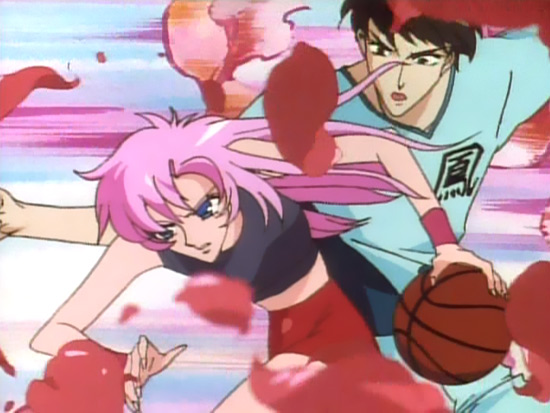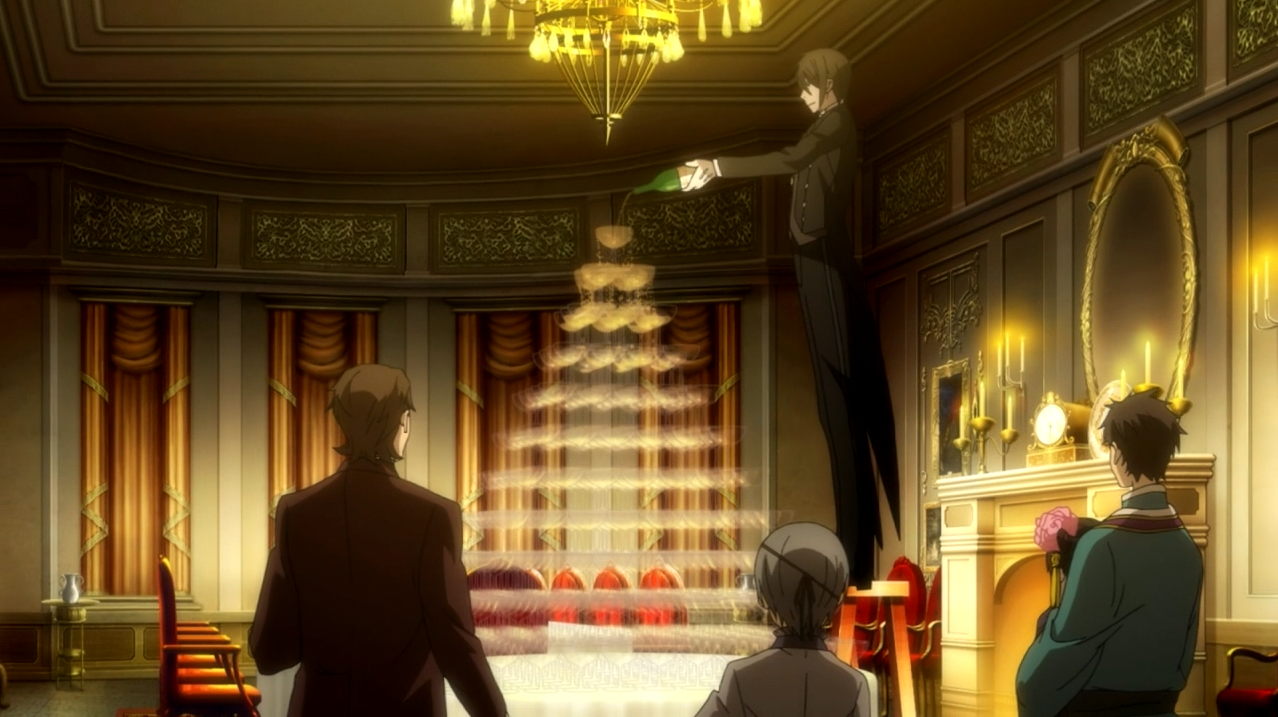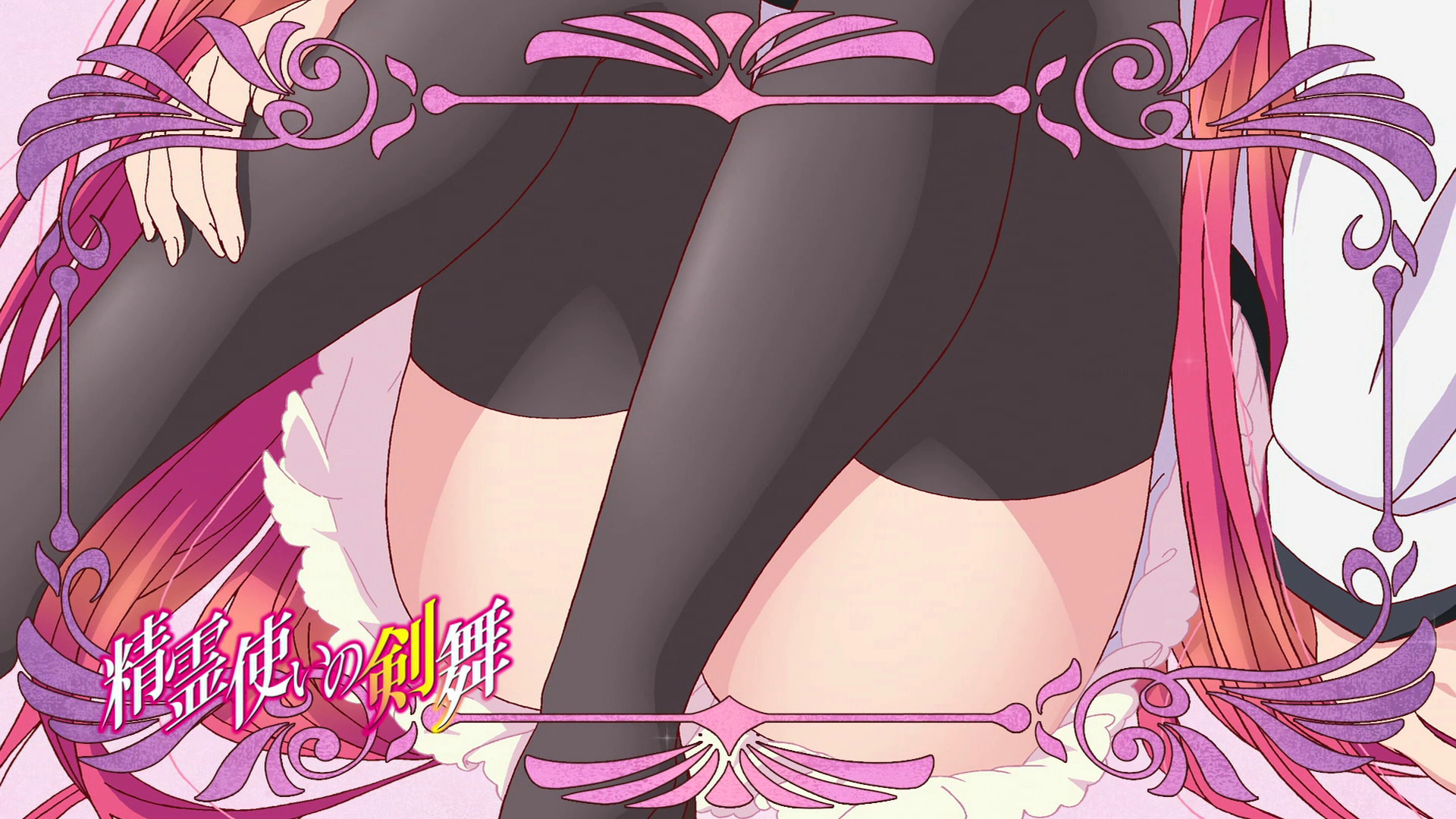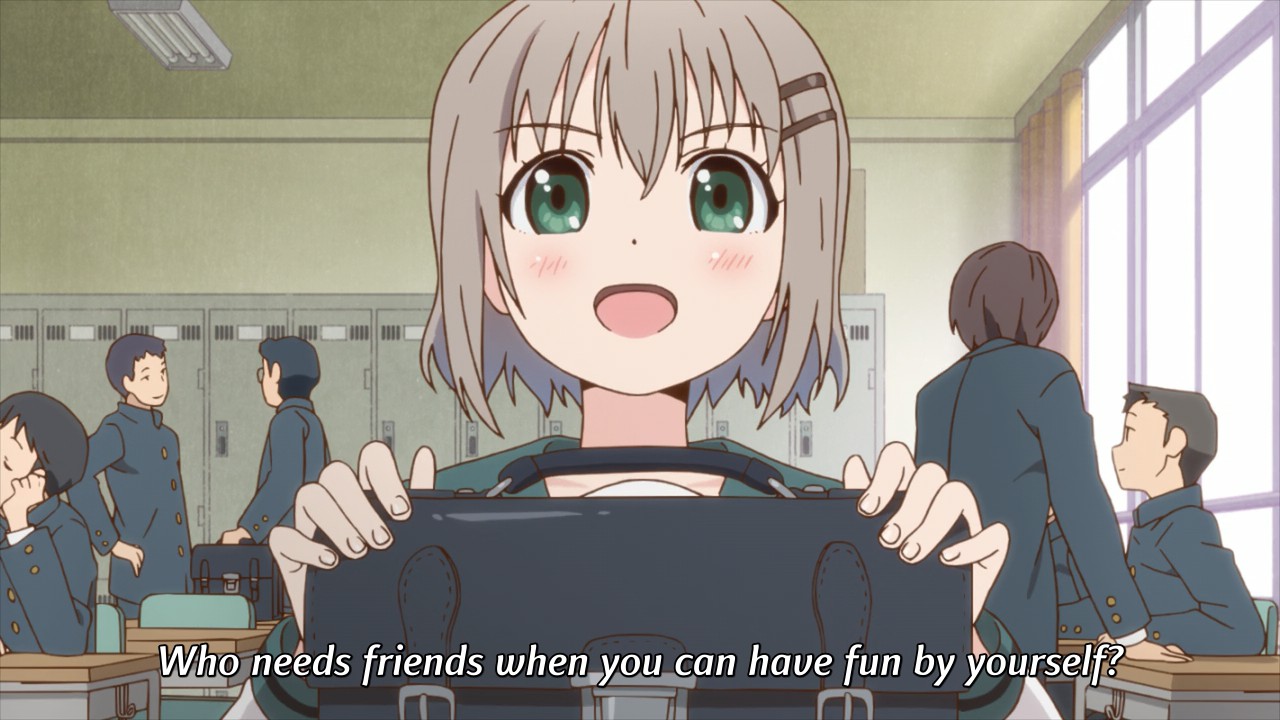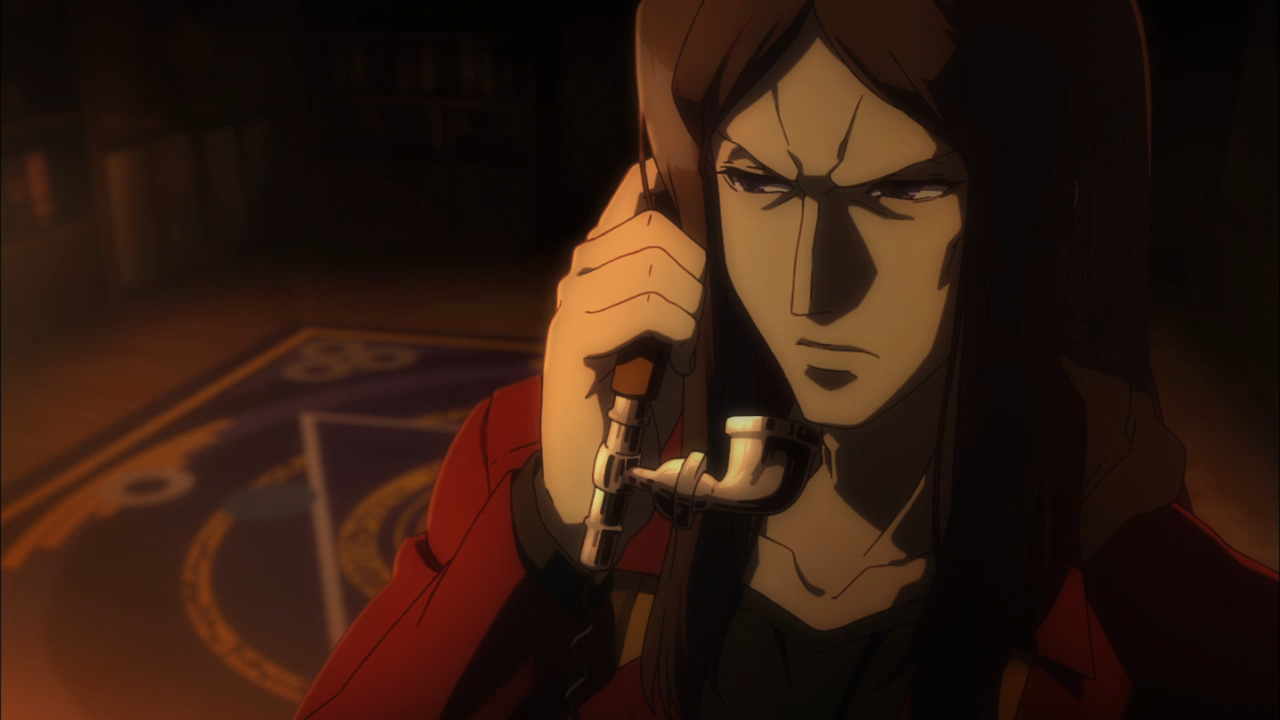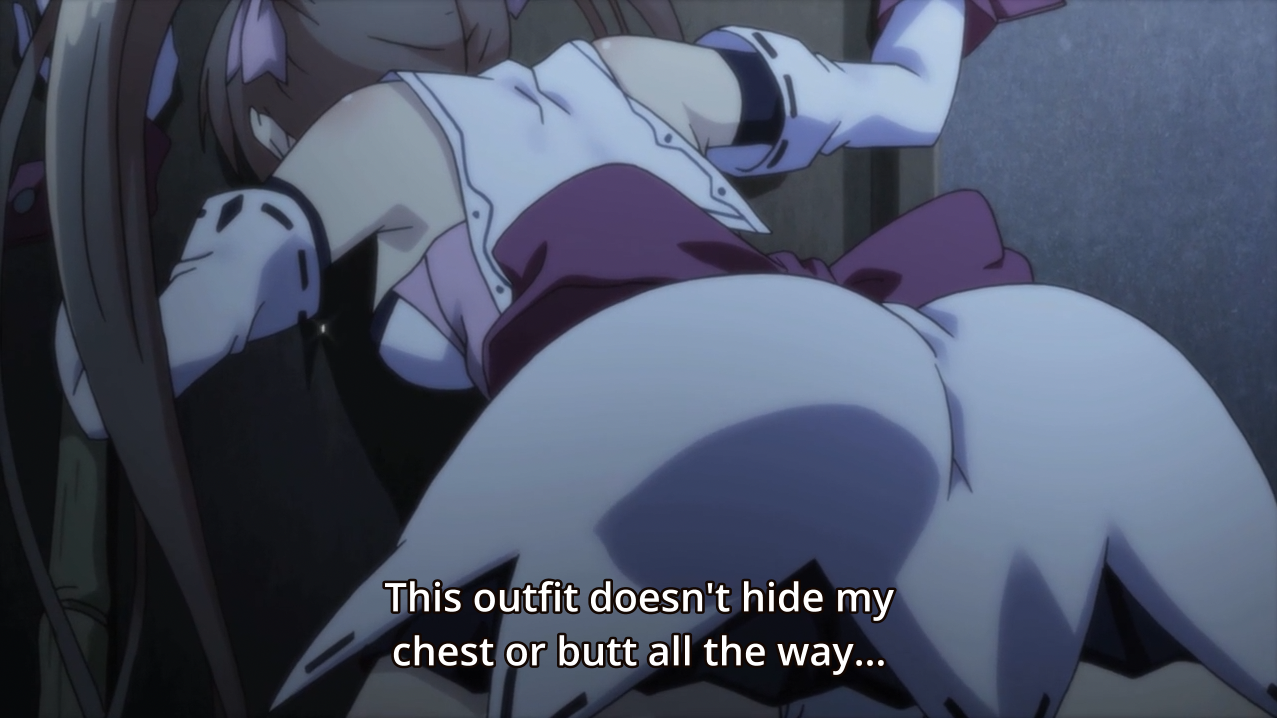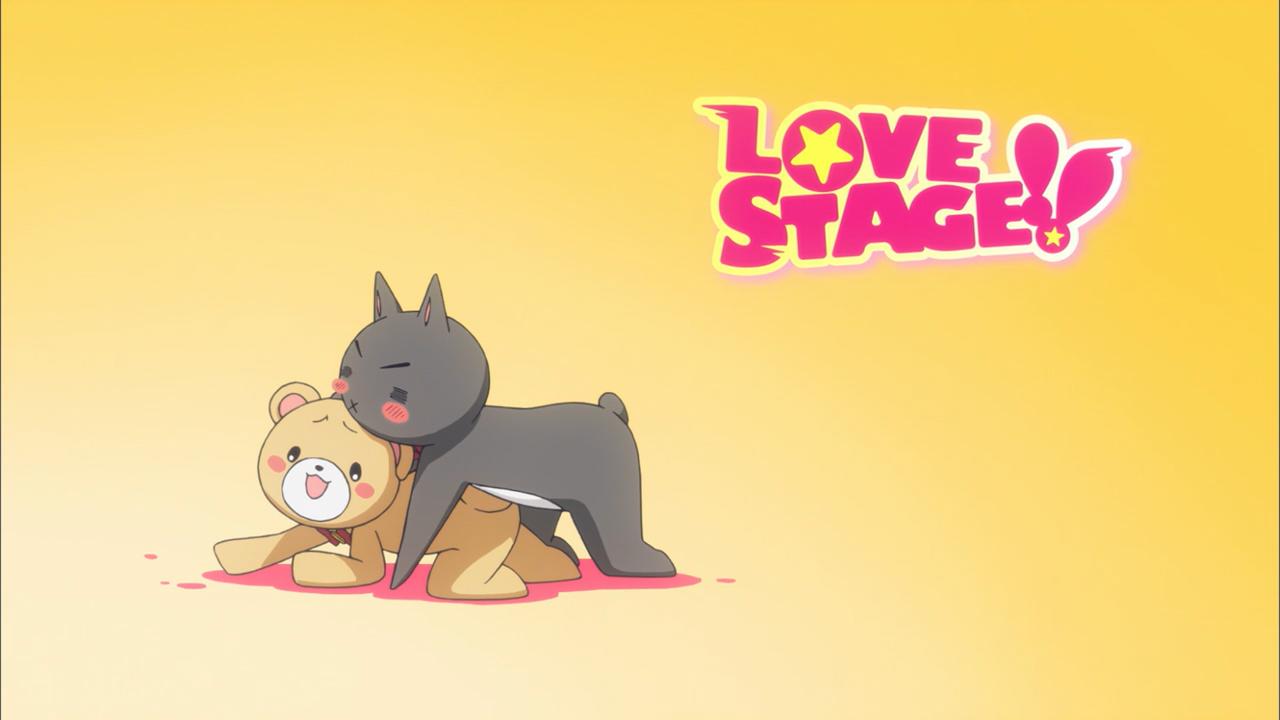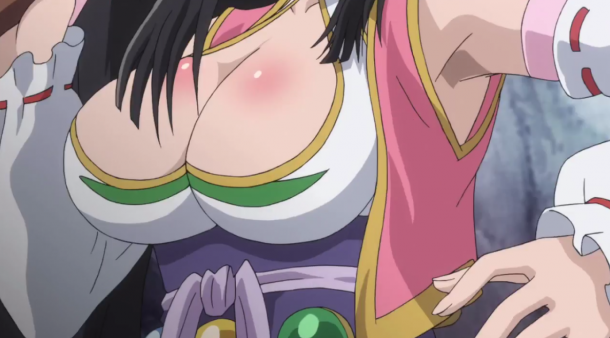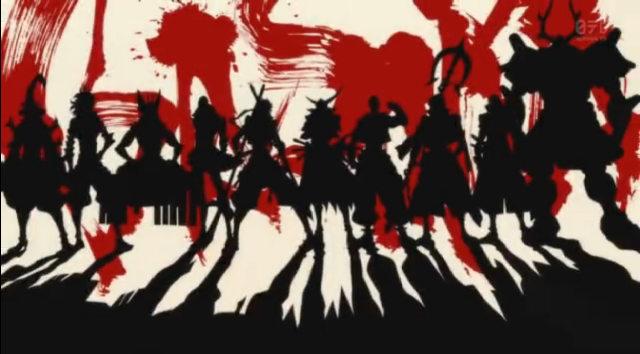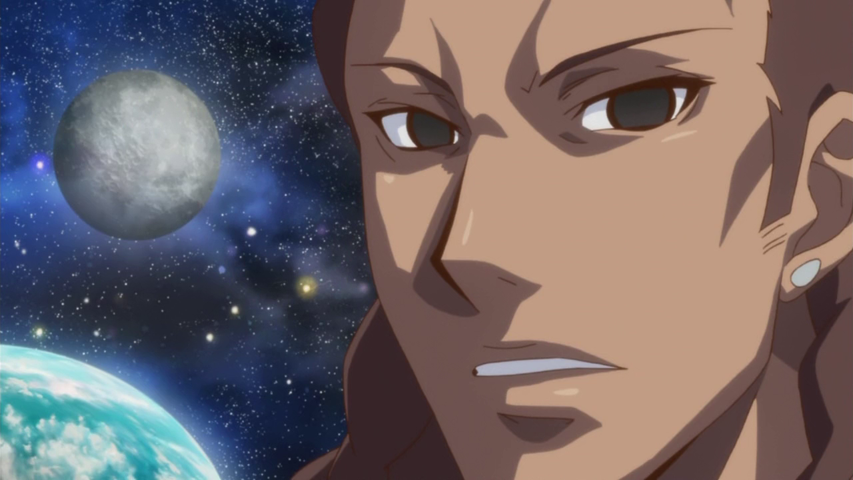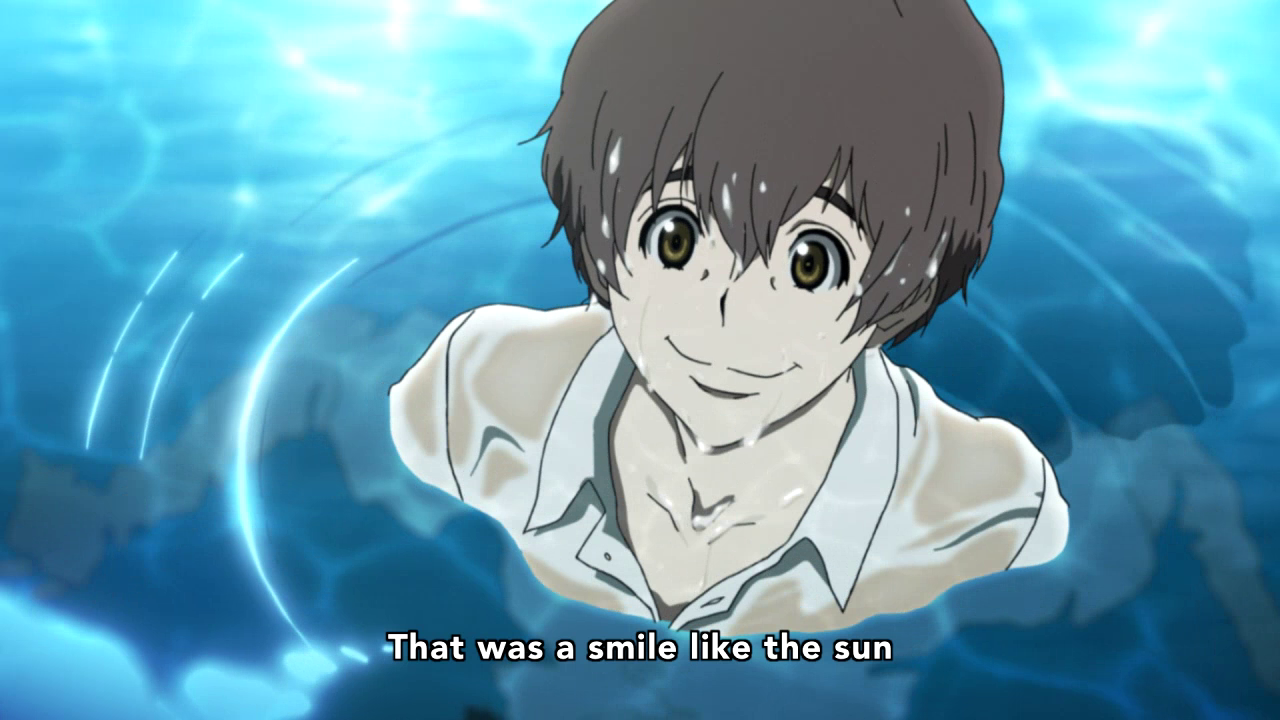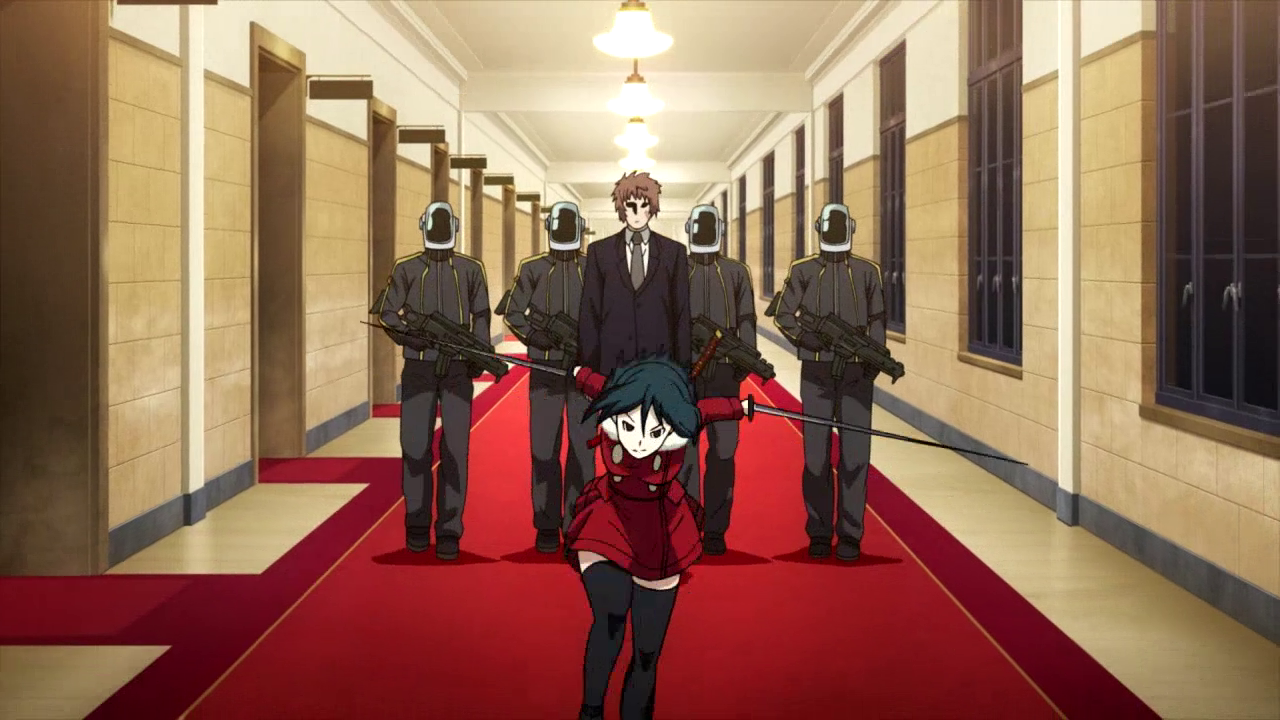Akame ga Kill!

I think she'd meet you half way on that.
So there’s this guy named Tatsumi who has the unfortunate distinction of being a dead ringer for Mikoto from Raildex (right down to the v-neck sweater). He and two others have been sent from their rapidly dwindling village to seek from protection from the corrupt, incompetent Capital of their country. But that’s not important. What is is a gang of super assassins known as Night Raid led by the titular character and her very large sword able to cut through a spinal cord in five seconds. Naturally our dorky hero wants to be a nice guy and fight the nasty assassins…until a series of increasingly grotesque revelations makes him reconsider his mission and interests.
AgK! initially wants you to think its just another generic fantasy land anime along the lines of Mondaiji and Dog Days, and for the first half of its first episode it kinda is…
…for the first half.
This being a White Fox production, all taboos immediately get thrown out the window and what follows is an ultraviolent, downright horrific decent into the gruesome underbelly of a decadent over the top civilization. Anyone who’s seen Jormungand would know that this studio does not pull punches when it comes to its blood ballets and that carries over Akame. The sheer multitude of slice and dice is so fluidly animated that I often felt like I was watching a movie instead of a tv show. The only problems are the writing does tend to go for the traditional shonen tropes and the setting is one we’ve seen more than a dozen times as of late (even if this is supposed to be a dark subversion). That said, now that this show has set its chosen path, I’m actually kinda interested to see where they go with it. — Lord Dalek
Second Opinion!
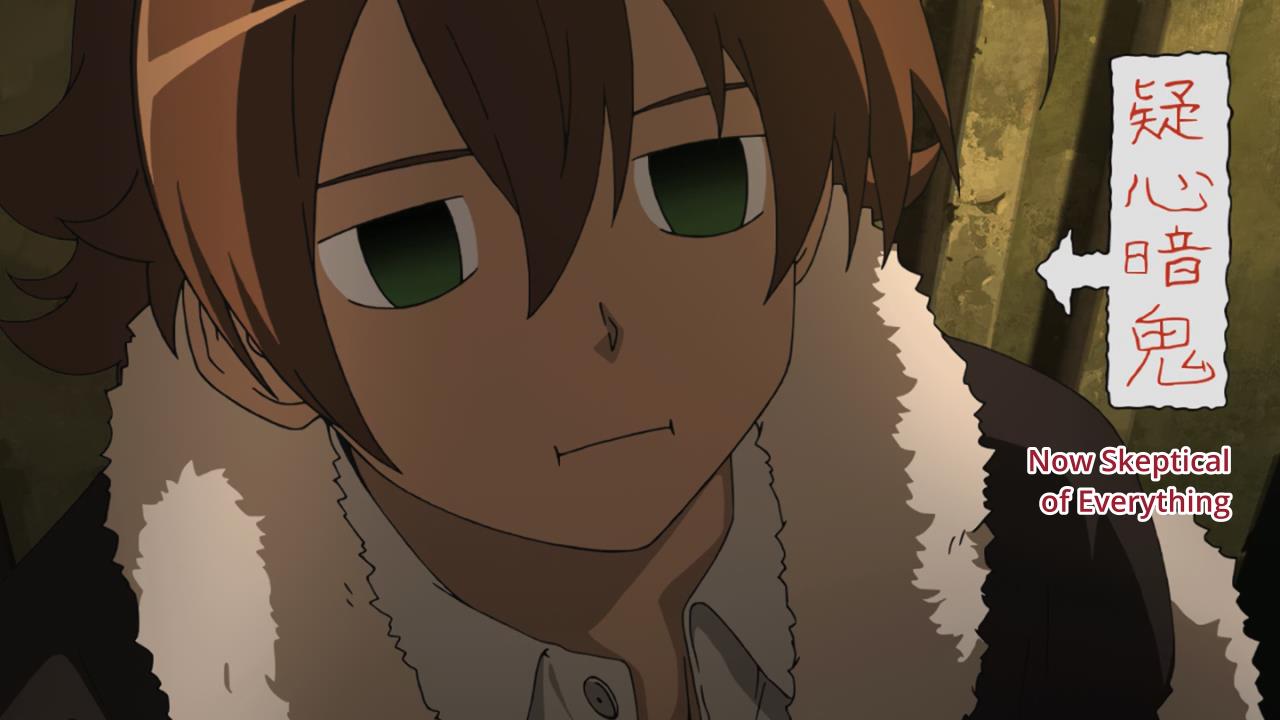
Me after watching this.
Wow, what a shift in tone and mood for studio White Fox! Having done recently the relatively, soft, safe and cute moe fest that was ”Is the Order a Rabbit?” last season, now that are doing Akame ga Kill, an action series that I am sure will rival last season’s Akuma no Riddle if perhaps surpassed it which wouldn’t be a hard task in of itself.
We are introduced to Tatsumi, a young shonen warrior. He’s your typical shonen protagonist: Strong, confident if a little over-eager and ambitious and a bit gullible/naive. He can take Danger Beasts and monsters like nothing and wants to make it big in the Capital of someplace reminding me of the middle ages, kind of. But its now a crawling fest of corruption; with a child emperor and an evil prime minister (oh gee where I have seen that before?). However, Night Raid, an assassins’ group, stalks the night and kill as needed, weeding out the evil encroached in the filthy corners and seeps of the city. This group is led by Akame, the cold emotionless girl really proficient with a sword and speed. Not to spoil, but suffice to say the last third is one of the most harrowing things I have seen in a first episode of a series ever. Its kind of a brilliant misdirection, if I am being honest. The show raises questions of ethics and the fine line of human morality, and I hope it continues that line of inquiry. Though, the one niggle I have now is that this show could turn into a ‘corrupt individual(s) of the week’ format with the vigilantes of the dark known as Night Raid taking down corrupt people left and right. Not that would be a bad thing, but it could possibly grow stale. Sure the story is basically shounen action with grimdark and edgy elements, but I’ll take that any day over stale by the numbers long-running series of the genre (cough Bleach, cough Naruto, cough One Piece, etc). I believe 24 episodes for this series is enough for it to tell a story and have some exciting action and violence without spoiling its stay.
The OP is rocking and cool and edgy. Animation by White Fox is top-notch stuff, filled with lots of shadows contrasted with bright colors and ambience. The fight sequences are well done with some truly brilliant animation. Also, yes there is lots of bloody and graphic violence. Not for the faint of heart. But for those interested, this is a good start for what should be a fascinating show to be sure. — The Eclectic Dude
Third Opinion!
As the closest person among the AR crew to being a far-right wingnut, I felt obligated to watch Akame ga Kill…
…It took me about a half-hour after I watched the 1st episode to wipe the cum off my keyboard with my commemorative McCain/Palin 2008 washcloth. This is weird for me since I didn’t think I could do that since my parents jammed a needle-thin crucifix up my pisshole and refuse to remove it until I find a nice Christian girl to marry (and even if that happened, they do not guarantee they’ll do so). Akame ga Kill really appeals to me in ways that shooting Uzis or feeding abortifacients to birds in the park (women by the way, not the winged animals) just can’t. The taut political subtext of people being at fault if somebody steals from them, high taxation, and the primitive urges of women shopping reveal a deep understanding to the human psyche that other anime like the woefully turgid Knights of Sidumbia and Aldumbnoah.Zero fail to inspire. And the violence? Woah. Every slice and every blood splatter caused me to cum uncontrollably, and given how it wasn’t a continuous flow it got really painful. I’ll have to stop the bleeding with toilet paper I tie-dyed to have a rainbow colour. Why did I do that? Not because I advocate Same-sex marriage, but because I wipe my ass on the very idea of equality.
In short, Akame ga Kill was my first and best sexual experience I’ve ever had. Now I’m going to pray to Jesus to forgive my sins, and ride my monster truck that’s pulled like a chariot by a Women’s Shot-put Team from the local Community College. Best anime. Bastard American Title for Detective Conan. 10000000/10. I am Calvin Coolidge’s waifu.
Real Review: I liked it. It was fun. There’s something gleeful in the carnage and the cast and setting is eccentric enough to make it work. It’s like Weiss Kreuz with a budget and with 100% less the seiyuu narcissism. Themes aren’t so much conservative but universal (I’m sure your parents taught you never to readily trust strangers you’ve just met and with regards to taxes, refer to Hollande’s France), and they don’t really get in the way of the story in the fashion I could best describe as… Mahoukey. After having to deal with shit like that or on the other end of the spectrum, Rail Wars, I’ll take my chances with Akane ga Kill.
Here’s to hoping it’ll get more awesome from here on out. — The Juude
Aldnoah.Zero
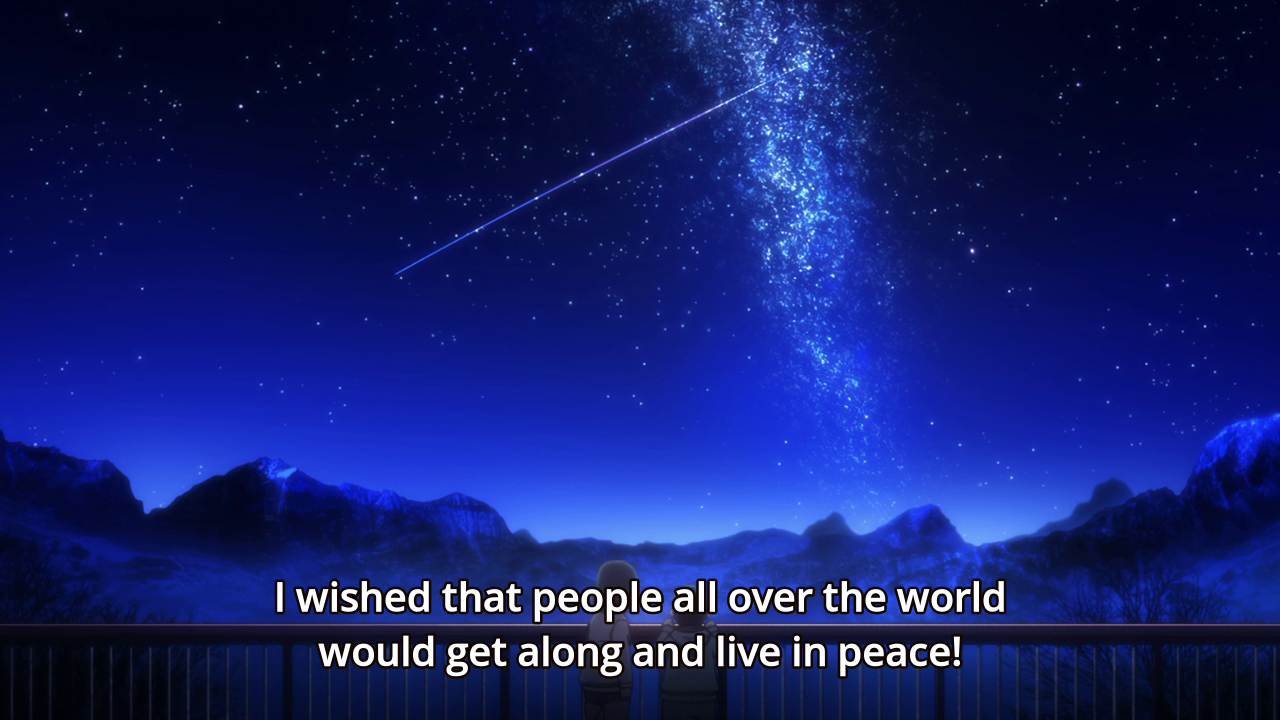
Cyborg 009 called. It wants its ending back...
By all accounts this should be a masterpiece. It reunites the creative team behind the fan favorite Fate/Zero (director Ei Aoki and screenwriter Gen Urobuchi), is the debut work by a promising studio, and has some pretty dazzling animation. Everything seems to be in order here and yet…it kinda sucks.
Oh don’t get me wrong, clearly the makers of Aldnoah.Zero have a lot invested in this episode. The problem is that this episode may or may not be completely unrepresentative of the show that is to follow. Due to the rather exteme nature of what transpires, its hard to really say anything about Aldnoah.Zero without spoiling lots of things so I’ll just run down the things I took issue with.
1. The characters: They’re an entirely uninteresting lot who I felt absolutely nothing for. To be fair this was also a problem with Fate/Zero, where much of the cast were nasty, unlikeable people but that made it work because you WEREN’T supposed to like those people (why root for an asshole like Kiritsugu other than the fact that Stay Night told you to?). This show? All I know is apparently the white haired kid and the black haired kid are the -tagonists and do almost jack poo in this episode. Why bother…
2. The plot: Ok stop me if you heard this before… In an alternate histo-its Code Geass. Seriously Gen… I love you, but remaking Code Geass is like the worst possible career move you could have made at this juncture. Nevermind the fact that they’re assholes from Mars instead of Anglo-American super powers this time around. That just highlights the fact you ripped off Gundam as well…I swear to god there isn’t an original bone in this show’s body.
3. The designs: I couldn’t put a finger on where I’d seen this show’s visual look before. Its like watching Fafner without seeing Gundam Seed first. Lets just say everybody looks really, really childish, in a Brave Saga sort of way.
And then… there’s the ending.
This is where the episode gets completely upended onto itself. Literally everything that could have gone wrong in the situation does go wrong, leaving us with one of (if not the) most emotionally disturbing pieces of Japanese animation since Barefoot Gen. Its like Mami in episode 3 of Madoka. Not leaving any room for us to recover, the episode simply ends there, proving that the Urobutcher’s capacity for shock value is second to none. Hell, those last two minutes almost saved the episode for me, but not quite.
The problem I have with these clusterfuck articles is I have to base all my opinions on the first episode and yet this one (in typical Urobuchi fashion) makes it so damn hard to do so. I’ll give it two more episodes before that other guy who wrote the thing with the shotas and the ice cubes and the whipped cream takes over to see what I REALLY think of Aldnoah.Zero. As it stands, the jury’s still out. — Lord Dalek
Second Opinion!
Gen Urobuchi rears his head once again, and after the rather gritty but ultimately good-natured, Gargantia, he’s going rote with Aldnoah.Zero.
What do I mean by rote? Well… Here we go. Earth and the Martian Vers Empire are in a tenuous phase of peace after a long war that started when Earth found some hyperdrive system on the Moon, allowing its citizens to travel to Mars. When one Princess Asseyrum is assassinated by Earth terrorists, it gives a bunch of Orbital Knights incentive to go and invade Earth. Now it may be up to… somebody maybe (the protagonist doesn’t even enter any specialized Kataphrakt (the name of the series’ mobile suits) to stop them and bring peace or whatever.
You see? Rote. The only thing that’s keeping me interested is the fact that Urobuchi is directing it. With that knowledge you should expect some unexpected, mind-shattering twist or foreshadowing that pulls the rug out or reveals that nothing is as it seems. However it is hard to think such when there is very little ambiguity in the setup. The main protagonists seem markedly okay if a bit cynical (with bright, circular, animu eyes), while the antagonists all have that beady look in their eyes and are eager for war. How Urobuchi is going to pull off some upsetting twist is hard for me to figure out after the Earth invasion is made, but really that’s all I’m interested in. I’m not curious about the characters, or their plight, I’m just curious to see how Urobuchi moves them like pawns in a potentially Kill ‘Em All Tomino-style bloodbath. At least in Madoka and Gargantia, I was not only curious about what Urobuchi was going to do, but actually cared for any and all characters present. I can’t here. I just can’t until maybe the next episode but who knows.
As of now, Aldnoah.Zero is Urobutcher at his most blasé. — The Juude
Barakamon
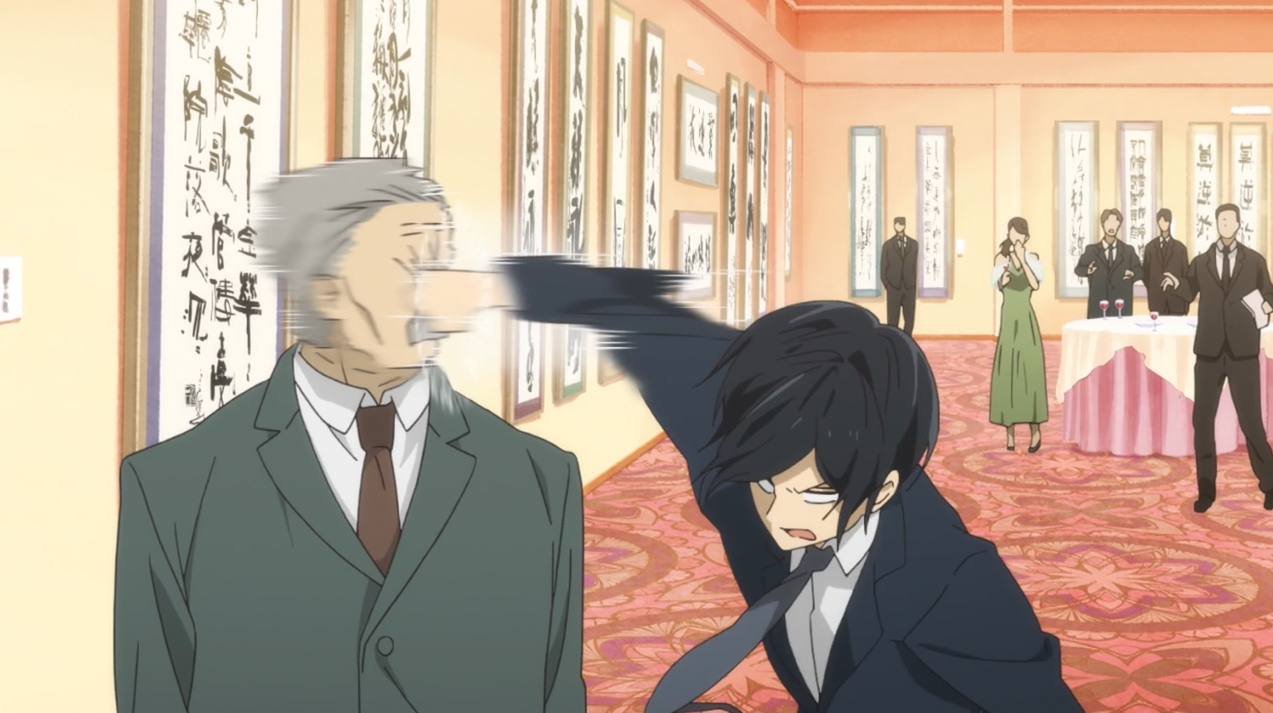
The most hotly anticipated action anime of 2014 has finally arrived.
Have you ever watched something and within the first few minutes known you were going to like it a lot? That’s been happening quite a bit more often with me recently. Such is the case with Barakamon, a nice, light story about a hot-headed calligrapher moving to an island village to cool off after punching someone famous at a calligraphy competition. It has this genuine air of comfort and sunniness to it that you rarely find in anime (or media in general) these days, and I really respect that; it’s nice to get a break from dark edginess, ultraviolence, and hyper-sexualized imagery every once in a while. In fact, perhaps it’s the sheer volume of darkness and adult themes in storytelling today that makes something like Barakamon so instantly likeable. Already in this first episode, we have a relaxing – if perhaps a bit overdone – setting, an easily relatable main character, and a cute foil for him who provides both laughs and “awws” throughout the majority of its runtime.
I will admit that I have a general bias for anime set in small, rural villages. The feeling of isolation from society can create atmosphere that runs the gamut from peaceful to oppressive depending on the tone of the story. Of course, this seems to be a generic setting for many slice of life series, but unlike the myriad of anime lodged within the genre of high school romantic comedy, I rarely get tired of shows like Barakamon. Perhaps it’s the allure of the unknown, and in seeing how different the village culture of Japan is from that of city folk the world over (I truly am a weeaboo, after all), but there’s just something I like about them. It also helps that this installment has incredible music and lots of fluid animation, showing that the staff clearly put a lot of time and effort into this production.
Handa is an excellent protagonist for a series like this. He’s clearly not a bad guy by any means, but his temper is very short, and he seems to often become frustrated by the silliest things, which he feels terrible about later. This reminds me a lot of myself, and will probably be relatable for many other viewers as well. While it doesn’t take long for him to warm up to the adorable Naru, – that rare child character who is actually cute and funny rather than obnoxious – the development is sensible and realistic. Judging by the OP and the episode’s conclusion, future installments will have him meeting a lot of eccentric villagers, which hopefully will improve the story rather than bog it down. Since much of the humor in this premiere is smart and lacking in barbs, I have high expectations for what comes next. Let’s hope I’m not let down! — Foggle
Blue Spring Ride

Me meeting new people.
As I grow older and more manly, my testosterone-filled heart consistently makes me like shoujo anime more and more. Case in point, Blue Spring Ride; two years ago, I might have stupidly written this off as girly romantic nonsense for teenagers, but not anymore. (I guess that’s called maturity?) This first episode was very sweet, but also somewhat depressing. Oh, who am I kidding… I almost cried during it. Multiple times. It’s pretty great. The art is lovely and the music is relaxing. The characters are charming and the situations are cute. It’s readily likeable if you enjoy straightforward romance, which I somehow have learned to do over the years. It seems my icy, jaded heart has finally melted and is now ready for me to let all that adorable lovey-dovey stuff in. As a 21 year old man with a deep voice and a thick beard, I think this anime is “totally kawaii XD.” But imagine me saying it in a way that’s isn’t as embarrassing or disgustingly weebish.
There isn’t a whole lot I can say about the story. It’s pretty basic, generic even, but also extremely engaging if you have a weakness for this stuff (I do). Futaba is a very likeable protagonist and reminds me a lot of myself when I was in high school. Mabuchi (“Tanaka-kun”) comes across as a bit of a prick, but it’s clear that he cares about her very deeply. The way he acts is a lot more realistic and less groan-worthy than your typical tsundere, and I think he’s probably going to end up being a pretty cool guy by the time episode 3 rolls around. The artwork is consistently good throughout, though I much preferred the beautiful watercolor look in the prologue and flashbacks to the more normal coloring seen in the majority of the episode. This is another great production from the awesome staff at I.G., with next to no technical aspects for my (admittedly untrained) eyes to find fault with. Fine work, ladies and gents!
I’m struggling to think of what more I can write about Blue Spring Ride. It’s showing a lot of potential in this first episode, so anyone who isn’t immediately averse to its genre should give it a look. And if you’re a fan of shoujo romance, know that this is an excellent premiere, and you should definitely watch it. But considering the apparent popularity of the source material, you probably didn’t need me to tell you that. — Foggle
DRAMAtical Murder

Once upon a time, there was a visual novel company named Nitroplus, founded by a man named Gen Urobuchi. Established by Saya no Uta and Steins;Gate, they rose through the ranks of Japanese game developers. That company spawned a subsidiary named Nitro+chiral. In 2012, Nitro+chiral made DRAMAtical Murder. In 2014, animation studio NAZ made that visual novel into an anime. That’s where we are today.
One of the only reasons to read the original visual novel was its love scenes – DMMD is a boys love game. The sad thing about changing the medium from visual novel to anime is that the love scenes disappear. In one fell swoop, DMMD lost appeal to me. No-one has ever written good love scenes, and that’s why they’re hilarious. That doesn’t matter with this anime, though, because there are other things to laugh at.
Aoba is a man with bright blue hair sporting a hairdo that makes people question whether he is male or female, and the show even talks to us about it. He works at a junk shop, with Ren, his mechanical dog that has the deepest voice imaginable. That dog spawned the meme ‘you fuck the dog’, which disappointed me, because you don’t fuck the dog in this anime, which also upsets my suppressed furry urges. He has a childhood friend named Kojaku, who is a lookalike of Auron from Final Fantasy X, but not as interesting yet. In this world, there is a game named Rhyme which isn’t really explained in this episode, but Aoba can perform some Rasengun-like attack when he is dragged into a Rhyme game, and his dog transforms into a human as the fight back from rebel rabbits. Terrifying stuff.
This episode establishes concepts I hope are explained in further episodes. I was kind of confused watching it, and I was also confused at how atrocious its animation could get. At some parts, Aoba was completely CG and so fake in comparison to the world around him. A robot that starts Rhyme up has a look that could petrify you as an example of subpar animation. NAZ is a newly established studio, so I shall cut them some slack, but the overuse of poor CG could’ve been handled better. Even better, no use at all. Overall, character designs are nothing special, animation is nothing special either.
The OP and ED are very nice music-wise, but as predicted, not animation wise. The music in the show was very futuristic sounding, fitting its aesthetic, but was the only memorable thing to emerge from this episode. I very much enjoyed its music. Everything else? Not that much. No fucking the dog, no watch. — Mahou
Free! Eternal Summer
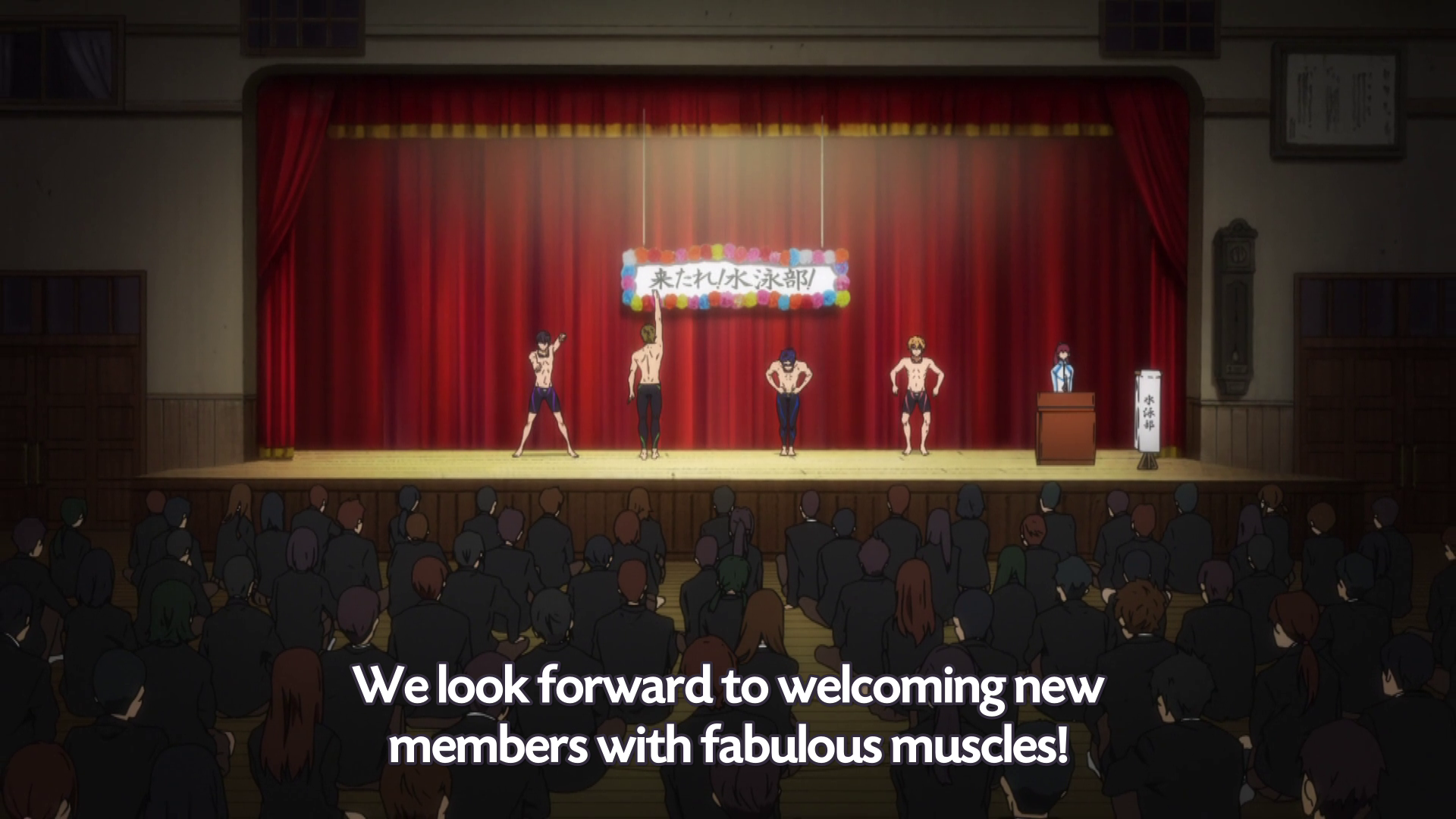
Heeeeeeeey ladies!
So yeah its this show… again… I mean why not? The first season made a mint compared to KyoAni’s other offerings from last year (the unbearable Tamako Market which somehow got a movie and Kyokai no Kanata, which will be lucky if its remembered one year from now) so naturally the Iwatobi boys would be getting a second dip in the pool. Hell its not like they didn’t warn us last year anyway.
Well anyway, its one year after the events of the original Free! Haruka and Rin don’t hate each other anymore, Nagisa still wants to ride Makoto’s dick, and Rin is…remembered. Last season was about building a team and challenging the pros. Now that that’s over, Eternal Summer is all about personnel maintenance issues. Iwatobi’s swim club is still hurting for members and Samezuka’s having to deal with the departure of their seniors and Rin’s rather abrupt promotion to team captain. There’s also the appearance of the mysterious Sosuke and his connections to Rin’s rather shady past.
Plot wise its nothing really, most of this is just setup for Animation Do’s beautifully animated swimming sequences, which are so fluid they might actually be rotoscoped. There’s also the usual Haruka’s a nevernude hijinx we’ve come to expect from this show plus the usual fujoshi enthralling, wince inducing, fan service of which there is a lot more of this episode. All in all, its more of the same, but that’s actually a good thing for Free! as its first season turned out to be a pleasant surprise for me. If Eternal Summer is lacking in anything, its that the ED just isn’t as fun as Splash Free was last year despite having even more bizarre animation. Not much of a demerit though really. Same old Free!, same old funny little show. — Lord Dalek
Glasslip
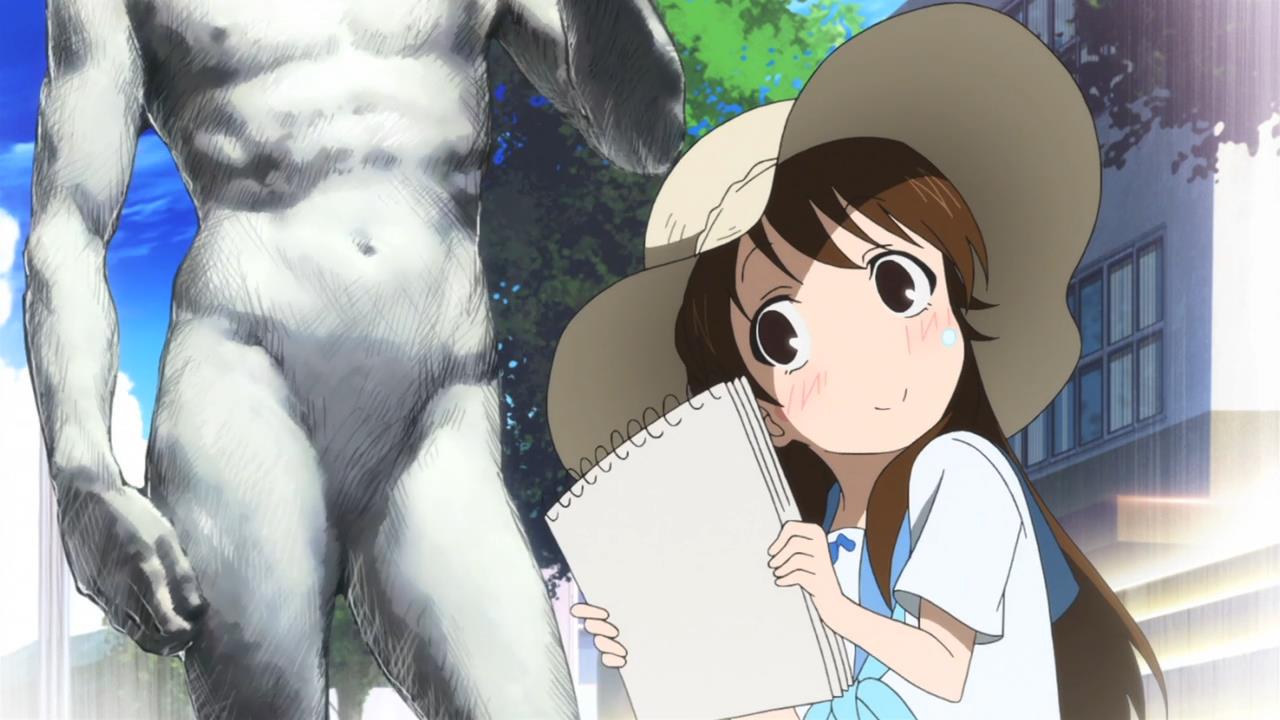
This is a very gentle anime where gentle characters do gentle things like raise gentle chickens while fireworks glisten gently in the gentle background. You could turn on the show as background noise, and you could still get most of the plot details even when paying the bare minimum of required attention. I know that the comparisons to previous PA Works shows have grown tired, but it still resonates when looking at this show. It’s another one of those shows where the main character gets thrown in an unfamiliar country, one where he has a slowly growing romance with a girl who also feels like a fish out of water. And while her quirky friends might see differently, the main girl learns to overcome prior inhibitions in order to be with this mysterious boy. There, I described half of PA Works’ shows.
But this show does not try to set itself apart, with the main guy saying artificial lines like “I saw you the other day at the festival. You were buying a bell.” or “Am I friend or foe?” And he says it with about as much emotion, so you can’t blame it on him being awkward. There’s no natural rhythm with him and the main girl Touko. It’s so stilted that they spend more time talking about the dietary habit of cats instead of their own self-interests. Maybe it’s trying to subvert the “love at first sight” cliché, but sometimes avoiding the formula will only mean going through an entirely new pitfall instead.
For example, chickens. This first episode is so obsessed with chickens, putting them in front of the characters that should be getting emotional development. Perhaps you could say it’s symbolism, like how the main characters are just as domesticated as the average chicken, so Touko raising a chicken seems like the blind leading the blind in a sense. Though if anything, that would be subtle given the show’s outward attempts at symbolism. There’s a one second close-up of an Albert Camus book to remind us just what we’re supposed to think about these characters, like “Hey if we reference existentialism, we will automatically become existentialist in tone!”
But to give the show credit, you can tell the director is having fun. I like how during the scenes where Touko’s with her family, they start doing old-timey anime tropes like the circle cut-ins and the sweat drops. It alludes to how she equates her home life with an older feel compared to what awaits after graduating high school. And given the director’s prior work on Ranma ½ and Urusei Yatsura, that kind of experience means these attempts to call back to an older time feel a bit genuine. Sure, the writing’s definitely not there to give the scenes power (I can’t believe I miss Mari Okada), but the show is definitely good at being pretty. — Bloody Marquis
Second Opinion!
It’s nearly the end of summer at some quaint Japanese town by the sea. A circle of friends are on their final year of high school, and all are uncertain about their friendship once it all ends. Add in some mysterious lad named Kakeru who says weird things and elicits weird reactions, and you’ve got the recipe for a summer so interesting that if you had it and you were famous you can probably adapt it for television purposes… Like Glasslip.
Didn’t expect much from this, was anticipating the jaw of this anime to be of the same quality as the lip. However the way the premiere carried itself was enough to force me to hold back my punch and instead wait and see what it has in store for me. In all honesty it does not seem bad. The entire aesthetic is rather pleasant, from the setting to the characters themselves. The show does a fair job in establishing a bit of charm in that regard, carrying itself in a way that does not come off as overly cloying, and got me to at the very least NOT hate most of the cast. It does a better job though, at really getting me interested in the title character. He may not be there through most of the episode, but his presence is felt and the way the show handles him inspires a nice sense of intrigue. He establishes strange, awkward, moral quandaries, is incredibly brusque and open, and inspires dislike amongst the cast.
Whether that will be a boon or a detriment to the show remains to be seen, but now I’m inordinately curious at how it’ll turn out and how it’ll affect the rest of the cast. They all seem like decent people, and I don’t want things to turn out TOO terribly for them. If that does happen though (and in the shittiest way possible), hopefully the show has a good doctor on call for reconstructive surgery if, like I said, its jaw can be described the same way as its lip. — The Juude
Hanayamata
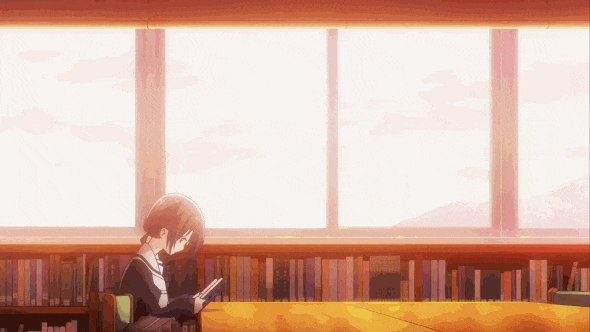
YURI ALERT
Ok yay, the dancing anime! Based on the seinen Manga Time Kirara Forward series of the same name, it concerns the story of Naru, a very average high school girl who wants to be something more than what she is now. She has an interest in fairy tales and herself lacking in well anything interesting in life. But one night she encounters ‘a fairy’: Hana, an American transfer student who’s into yosakoi which is essentially traditional japanese dance. She’s a very optimistic and hopeful, which warms my heart and touches me more so than any downbeat or dour protagonists. She is very persistent and perhaps a bit affectionate towards our blushing heroine.
We are also introduced to some characters, as expected for a first episode: Yaya, her closest friend and part of the school band which they actually play a bit in the episode, take that K-On! There’s also some megane babe and Tami, a ojou-onee-chan figure to Naru.
So, I love this. Really, I do. It boasts some truly beautiful artwork and visuals, thanks in no small part to Atsuko Ishizuka and her Madhouse production crew, who previously directed last season’s utterly fabulous No Game No Life. The backgrounds are very colorful and shiny, and the characters look moe but only enough to not be overdone. This is also the first very Japanese anime I have watched in a while, right down to the music which is traditional japanese sound. And the writing complements this, due to having the mistress of SoL anime Reiko Yoshida. Its nice, crisp and clean, even poetic at times That and it does a great job of juggling the rather melodramatic or contemplative moments with some nice comedic bits, such as Hana chasing Naru down around the school.
Oh yeah and the OP is very upbeat and energetic and get this: NO CGI DANCING (which has Precure beat by the long shot totally)! And hey its certainly worth a look more than the OTHER Madhouse anime airing this season as well. I am so pumped! — The Eclectic Dude
Jinsei, La Bonne Vie
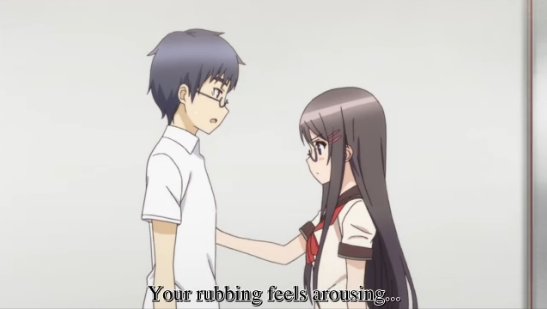
Jinsei is a show I wish was my everyday life was like when I was in highschool. I mean, while I was actually in highschool, not interfering with my own personal time. At the same time, I wish Jinsei had a little flavour to it that wasn’t bitter, but that’s the feeling it leaves once you finish watching a show that should’ve been a 7-minute short. I don’t want my former highschool life reminding me of black coffee. I like some sweetner with my coffee.
Jinsei‘s 1st episode is more three 7-minute segments in which our cast take part in wacky adventures as part of a club in which they council their fellow highschool students. Our cast, you ask? Yuki Akamatsu, a dude with glasses and our main protagonist, Rino Endo, a Homura Akemi lookalike with a love for science and a lack of social interaction with boys and Yuki’s forced love interest, Fumi Kojo, the resident Mikuru-archetype character, Ikumi Suzuki, an athlete who fights with Rino, and Ayaka Nikaidou, the Kanade Tachibana clone who ropes Yuki into this club. Wondrous adventures ensue.
Jinsei uses Rino in a way to make the show look unique, by having her spout scientific statements that allow the audience to question things, and also to provide comic relief with Ikumi, the airhead who cares little for Rino’s hobby. The comic relief isn’t really comedic, but I was expecting that. Few anime can capture actual laughter-enducing comedy, and statements about ‘pre-determined destiny’ doesn’t evoke the response I think Jinsei was hoping. It instead made me question why I was watching this show.
The show is also pretty fanservice-y, and the first segment includes a water fight and seeing bras through wetted gym clothes. Most shows would wait a while for that, but not Jinsei! It dives straight into that pool (haha) with water balloons and matrix-style dodging and science-spouting. Humour, right?
A couple of things made me giggle, but I can’t really remember anything I got from this show. I like the way Yuki’s hair was coloured? The animation was decent for a feel. show? The music reminded me of Haruhi Suzumiya, only less memorable? Using people’s problems as a plot device could lead to some interesting concepts in later episodes? Maybe the forced romance between Yuki and Rino won’t be so forced later? I don’t know. Rino was the smart girl with no idea how to talk to people (more specifically boys), something I’ve seen so many times before. This show offers nothing new. It even includes its own ‘Sonic Says’ at the end of every segment. That’s no good. — Mahou
Locodol
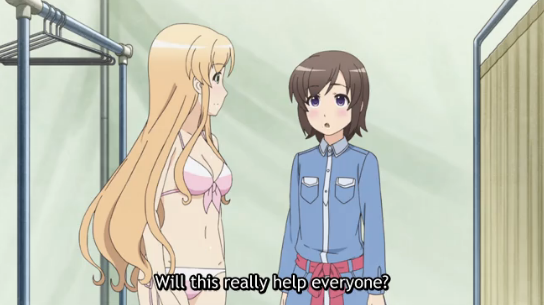
Unfortunately, Locodol is not about batshit crazy Idols. Instead it does something different with the idol anime concept and focuses on the local idol scene (hence the title “locodol”). Story begins when Nanako Usami, desperate to buy her own swimsuit so she can star in the lesbian version of “Free!” makes a deal with her uncle to sign up for an unspecified job to get some cash. To her surprise (and chagrin) she has unwittingly signed herself to become a locodol (should’ve read the fine print), her uncle is a local politician worried about the declining youth populace, and he thinks that sponsoring a couple of local idols would bring attention to their small town and increase interest among the young people. Fortunately, the reluctant Nanako is partnered with the kind and gentle Yukari. After an awkward and near-disastorous start, the audience finally starts cheering for them once they actually start playing.
I don’t really have much to say about Locodol. I don’t watch idol anime, so I can’t really compare it to anything, and most of the episode didn’t really do anything for me. Things started to get interesting once Yukari showed up, I guess, but otherwise this was pretty forgetable as far as premiere’s go. It probably doesn’t come as a surprise that I was more interested in Nanako and Yukari’s relationship than any of the stuff pertaining to the locodols or Nanako’s swimsuit problem. Nanako and Yukari do have a cute (if cliche) dynamic going on, so seeing their relationship develop is something to look forward to for those who like that sort of thing.
This is pretty much all I have to say. If you want to see an idol anime that does something different, then check it out, you’ll probably get more out of it then I did. — Rynnec
Mobile Suit Gundam-san
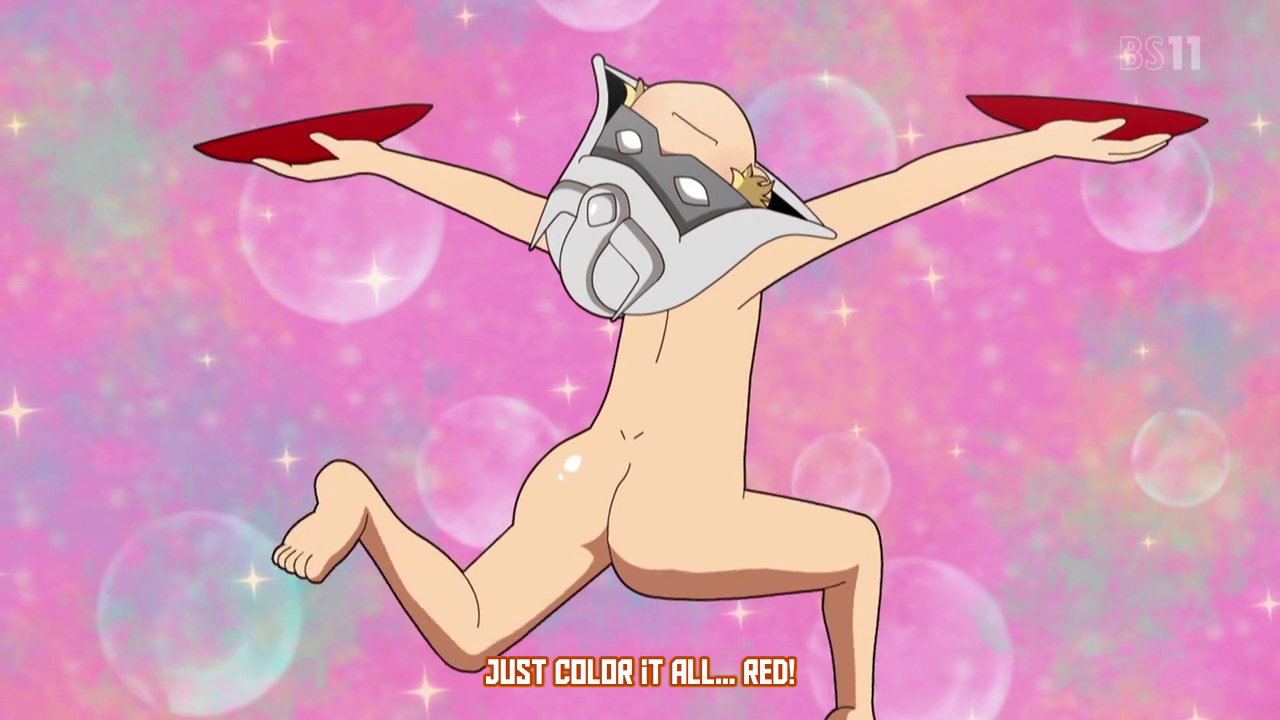
Wot iz dis I dun't evan.
Congratulations Seed Destiny… you’re no longer at the bottom. — Lord Dalek
Second Opinion!
People who are not fans of Gundam need not apply. Those who are? Apply! Apply! Apply!
I like it when Gundam is complete, utter, nonsense. I hope this ranks with the best of the old school SD Gundam era (the ones with the boppin’), and so far it seems to want to play that part. Gundam’s always been a show that took itself way too seriously, and moments that takes the piss out of the franchise like this one, should always been highly valued and watched. — The Juude
Monthly Girls’ Nozaki-kun

I like some shojo. Daytime Shooting Star, for example. That’s a nice little manga right there. Missions of Love is a guilty pleasure for me due to its artwork, and My Little Monster was a disappointment in the end – both its manga and anime versions, despite the high hopes the anime gave me from its first episode. Blue Spring Ride is a shojo series coupled with Monthly Girls’ Nozaki-kun this season, and I don’t know what Blue Spring Ride is like, but I like the impression Monthly Girls’ Nozaki-kun left me.
Monthly Girls’ Nozaki-kun follows Chiyo Sakura, a highschool student with a crush on Umetaro Nozaki, the titular character who I initially thought was Chiyo’s teacher – he’s ‘tall and manly’ in Chiyo’s words, and he doesn’t look like a highschool student at all. Confessing her love to him through calling herself a fan of his, Chiyo ends up working for Nozaki as his assistant – you see, Nozaki draws shojo manga and is published under the pseudonym Sakiko Yumeno, and his works sell very well. Using this as a way to get close to him and finally confess her love to him, Chiyo and Nozaki draw manga together.
The premise reminds me a little of Missions of Love (manga artist looking for inspiration), but Nozaki-kun feels genuine and not as forceful as that manga was, and I don’t see any incest anywhere in this anime yet. Yeah, Chiyo’s a little shy, but most people are afraid of confessing their feelings to the person they romantically love. The show’s attempt at humour actually got through to me, as a segment utilizing bikes made me giggle a lot. The show is also pretty cute too, and I do think Nozaki is nice to look at for a 2D character, but that’s all I’m saying. Chiyo’s bows are cute too. Hell, she’s cute in general.
The OP is really nice to listen to, and the ED is sweet stuff. The music in the show is typical shojo-stuff, but is nice to listen to. The voice acting isn’t grating, and again, Nozaki is nice to listen to as he is to look at. The animation, provided by Dogakobo of YuruYuri fame, is quite fluid during the more demanding segments and is nice to look at in general. Character design is nothing special and it seems like a typical shojo look, but I hope the characters themselves fully shine by the time the show sets itself in motion, so character design does not bother me in this regard. I look forward to seeing what this show has to offer.
Now, if you excuse me, I’m waiting for Umibe no Onnanoko to have an anime adaptation. Imagine it. — Mahou
Pretty Guardian Sailor Moon Crystal

It's 1992 all over again.
In the early 90’s 2014, Usagi Tsukino is a bubble headed crybaby twat who gets bad grades, plays too many video games, and ends up locked out of her house every night. She also has a recurring dream of a prince and princess holding each other’s hands for reasons that remain unclear (I’M TRYING NOT TO SPOIL HERE) at the present time. Things get more interesting when a talking cat named Luna struts into her life with a magic brooch and the command to fight crime and find a missing princess as the legendary guardian, Sailor Moon. Naturally Usagi sucks at this, as anybody who’s watched a single episode of the original show would attest to.
So after forty million rumors, delays, and denials, Toei has finally gotten off their asses and remade Sailor Moon in a version reportedly adhering much closer to the original manga than the previous show ever did. Frankly I couldn’t really guess that from the first episode since it retells the same story that the first episode of Classic did. Its the jewelery store monster again, it has the same modus opperendi as before, and it gets killed exactly the same way. Aside from that, there are some differences. Usagi’s first run in with Mamoru plays out a bit differently, as does the first appearance of Tuxedo Mask (they aren’t even trying to conceal his identity this time) giving him an explanation as to why he was at the jewelery store in the first place.
The animation is the usual Toei meh, bringing into question why they’re bothering with the bi-weekly format since it isn’t translating into actual results. Still looks much better than the old show though, despite the cgi transformation sequence. Cast wise, everybody’s new save for Kotono Mitsuishi who sadly confirms my suspicion that she’s way too old to play this role now and gives a very forced performance. That said, I was having too much fun to really care.
Ultimately, this is the kind of show you watch not because its good or bad or anything, but because you wanna remind yourself of the good ol’ days of Toonami. Shame then that the next episode isn’t next week. — Lord Dalek
Second Opinion!
Let’s look at Sailor Moon from a historical context. As every pop culture snob will tell you, Sailor Moon was one of the first and most influential anime of its kind. You could say other works like Cutie Honey and Princess Knight did it first, but either poor writing or dodgy values at the time prevented them from resonating with audiences the way this series did. It opened the floodgates for girls tired of regular shoujo, excited that they could finally get heroes who could duke it out with monsters and win. And the characters weren’t treated like generic strong female characters, but people with their own self-interests and issues.
Sure, Sailor Moon had to rely on Tuxedo Mask’s help in the beginning, but he’s only a piece of her connection with the world rather than her sole reason for being. In short, the show advocated people who were in charge of their lives rather than chained by problematic relationships. While that might seem expected by today’s standards, remember that characters like Asuna are thriving years after the series originally ended. It’s easy to look at the show and think “Haha! This is so dated!”, but that aspect of Sailor Moon—how you don’t let anyone else but you control your own destiny—is why people have been talking about the show decades since it ended. It made people feel like if someone like Usagi could accomplish things in her life, then they surely could.
That said, this remake acts as if none of that has happened, set in the exact same time as the original show with nary a sense of modernization involved. So it’s good news for nostalgic romantics, because nothing has changed. But there’s pity for any newcomers, because nothing has changed. Character designs are shined up. Scenes are made with more finesse than in the 90s. But other than that, this is just a retread of the first episode from the previous show. I know people like to criticize the live-action series for being weird, but at least it showed that it was going to do something original from the beginning. Here, it feels like ground that’s been tread already. — Bloody Marquis
Rail Wars!
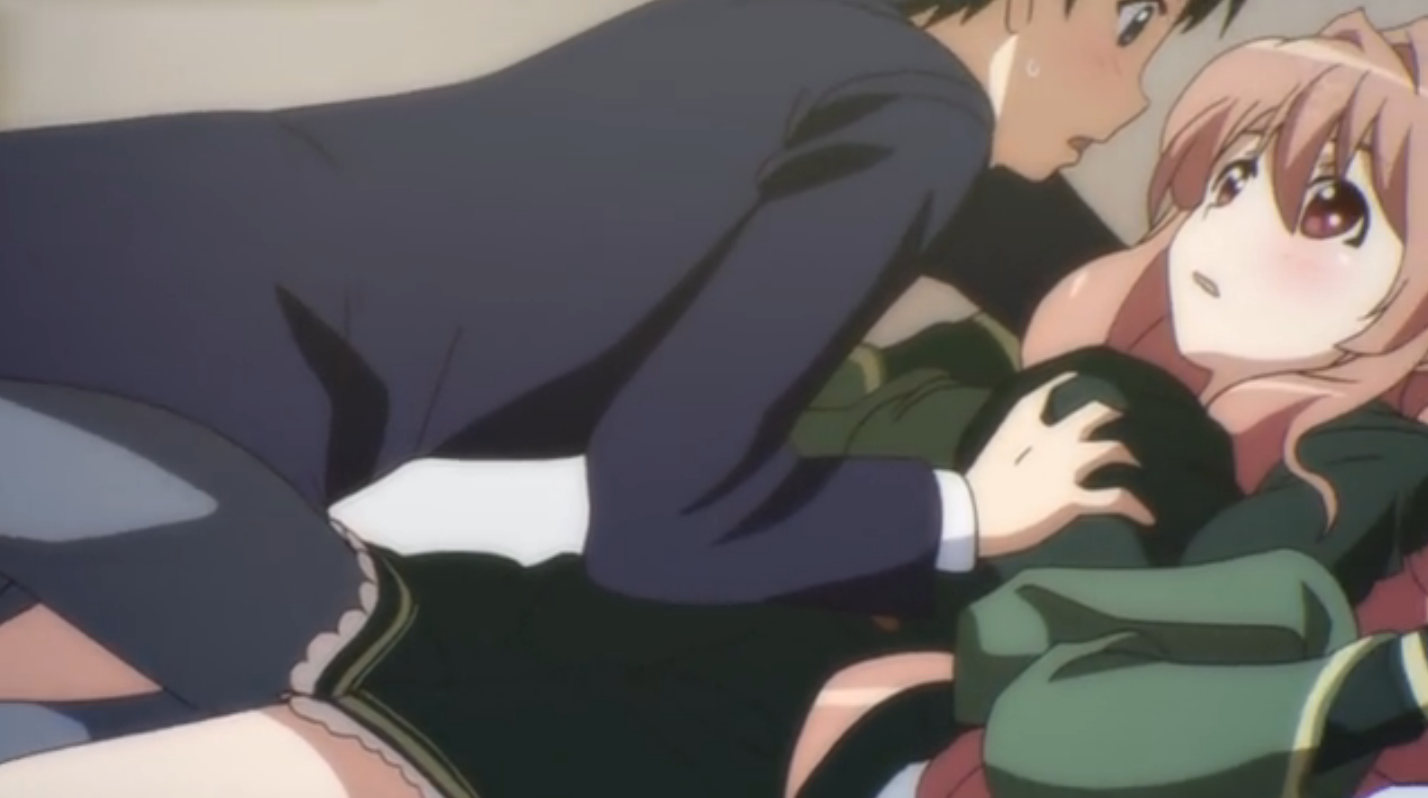
Ya gotta hand it to Japan; they know how to strike a sound ideological balance when it comes to mediocre anime currently on air. On the one hand, you have Randian falderal like Mahouka, and on the other you have maudlin statist pap like Rail Wars.
Am I over exaggerating? Yes, but I couldn’t help but feel the spirit of Mussolini flow through the dialogue of Seijun Densha Otoko (apparently called Takayama Naoto, but fuck it he’s Normal Train Guy), as he goes full otaku on the magic of the Japanese railway. It is something so magical that every Ryu, Ken, and Yoko should participate in such a corner of the public sector, in SDO’s case, the public safety sector. All within the rails, nothing outside the rails, nothing against the rails!
This said all that gregarious spirit is all artificial talk by artificial constructs. You got SDO, the tsundere red-head, the eager hot-blooded macho guy, and the large, friendly pair of breasts attached to a reanimated corpse as they just follow rote team bonding. Or at least that would be the case if their entire time training to be part of the Public Safety division wasn’t relegated to small flashbacks that insinuate growth, an intense live exercise involving the proper shoveling of coal, and catching purse snatchers. Oh man, that last one? Instead of y’know… an intense car chase or some over-the-top sequence like in the first episode of Wizard Barristers, they just find some train that arrives to where the thieves are going to be earlier and then everything is right as rain!
Honestly if they were going to skim their entire training and camaraderie arc in one episode just to get them all in the same Public Safety unit by episode’s end, why not just start with them already on the job? Spares us the usual “training/exam” dog and pony show and instead lets us get to know the characters on the job and why exactly is this anime called Rail Wars. If there’s any war going on it’s between boredom and I with regards to paying attention to this show. So far, boredom’s winning and I’m ready to hoist the white flag.
Sorry, Il Duce. — The Juude
Re:␣Hamatora
What an absolutely godawful title. Between that and its choice of director (the “illustrious” Seiji Kishi), I nearly refused to watch Re:␣Hamatora purely on principle.
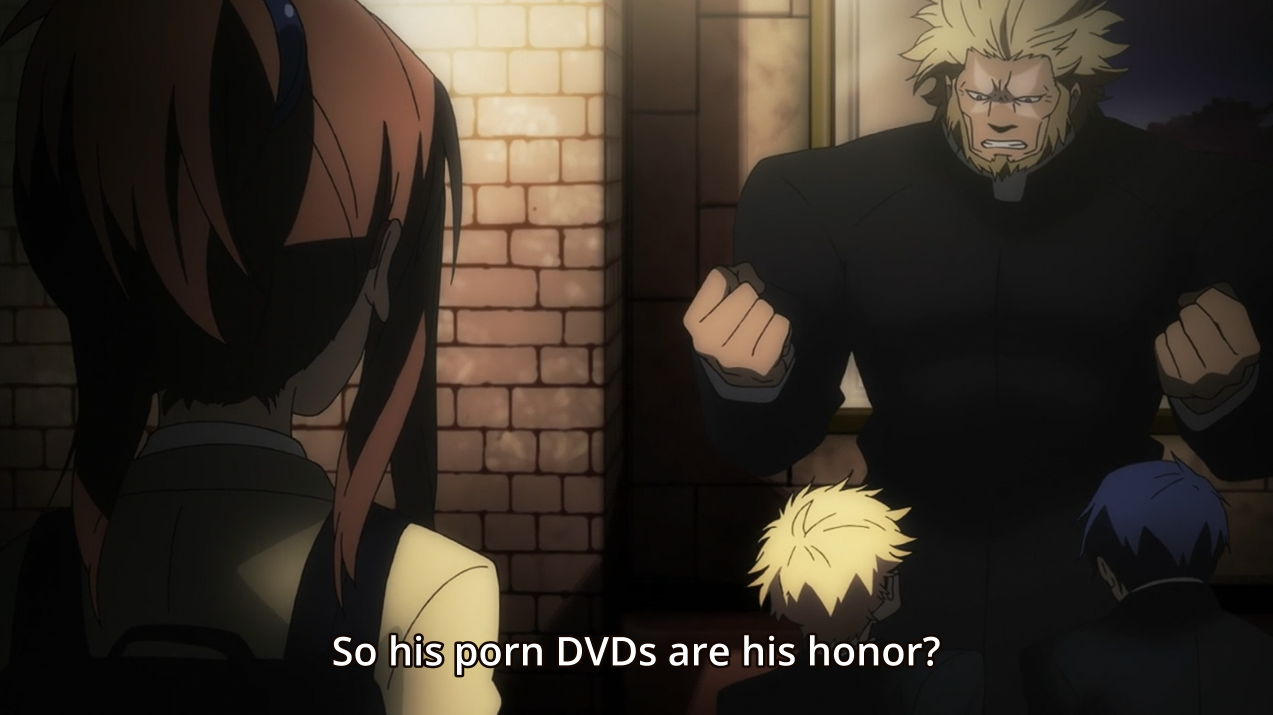
I wish I had.
Right off the bat, this series oozes style. Granted, it’s the kind of style a third-rate director would hastily cobble together after his first playthrough of No More Heroes, but there’s style nonetheless. I mean, seriously; the way the text zooms in during the opening credits, the various scene transitions, the soundtrack… it all screams No More Heroes ripoff. Putting that aside, there’s really nothing else here. The writing and directing are so bad that the staff literally had to cop someone else’s style for their work to seem relevant.
The characters fail to exhibit any likeable traits, the plot twists (if you can call them that) can be guessed almost immediately, and the comedy repeatedly falls flat. While the music is fantastic, everything else about this anime just pisses me off. The story is barely there, trading character development opportunities for cheap, unfunny gags. In typical Lerche fashion, the character design – while not too terrible this time around – really bugs me for some reason. That goddamn NMH scene transition pops up almost as often as the swirling logo from the original Transformers cartoon did. And it really takes some balls for someone like Seiji Kishi to make fun of bad visual novels when that’s exactly what every single one of his shows has resembled to this day, regardless of the source material’s quality.
The scant bit of action in this episode (I’m talking maybe 5 seconds-worth, no more) was well done, but good lord. Music aside, Hamatora‘s season premiere has no redeeming qualities. How Lerche and Seiji Kishi still get work, I’ll never know. This is one for the compost pile. — Foggle
Samurai Jam – Bakumatsu Rock
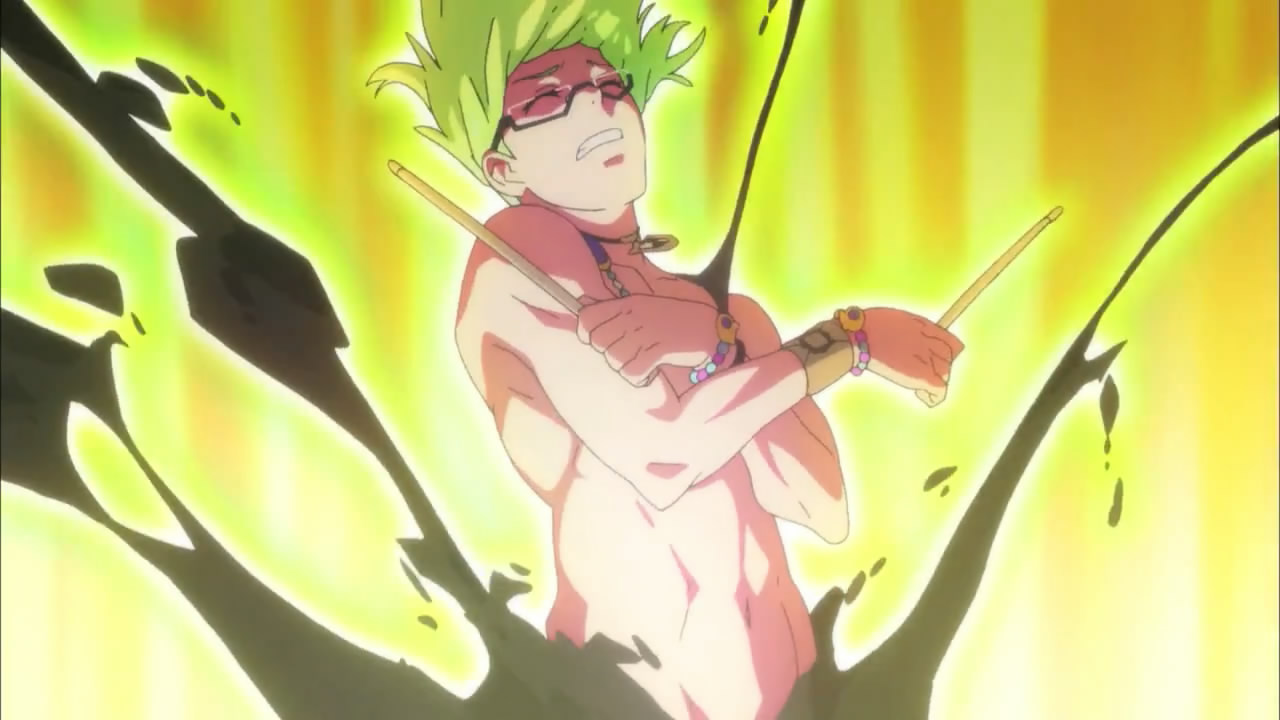
The power of J-Rock makes me shoot black goo too.
In another world, this show could be a contemplation on how Western culture is decimating what little remains of Japanese culture. It could cast a light on how a world of shamisens and sake is being steadily replaced with guitars and pizza, with the dying rays of the rising sun met with a song instead of a whimper. Could this new world be welcoming or ultimately destructive, further asking if the old ways should be challenged like this? And ultimately, can this new fusion of the arts thrive in a conservative realm like Japan? Only a skilled artist could potentially answer these questions. But this is not another world of such possibilities. Instead, the artist we have now is Studio DEEN, and such questions are only the echoes from an excuse to combine pretty boy aesthetics with the Tokugawa era.
I can definitely see some unintended questions pertaining to that discord between cultures though. This show has the usual “society trying to block out our music” cliché that pops up in every media involving aspiring bands. This show’s a bit unsubtle with this by having white-robed government agents attack the main characters, which makes the power of rock message the show keeps shilling seem a bit tired. It’s not exactly a show you could watch for the political intrigue rising between musical and government-accepted culture. Even so, I’m still interested as to why they picked this era of Japan to shove this glitz into. I suppose the original creators were looking for some era that would immediately reject pseudo-rock music, and what better than the 1800s? But why not set it at the 1500s so we can have a Visual Kei Nobunaga along with his shota spouse Ranmaru trying to step on their potential reign?
But once again, it’s not a show designed to challenge the walls of history but rather the walls underneath a fangirl’s panties. So if I had to critique the show on that standpoint instead… not enough shirtless men? Aside from the ghost kid and the glasses guy, the cast wasn’t hot enough? No Yuuki Kaji character to tickle your eardrums? I’m sure potential viewers are annoyed that these potential spices are absent from this series. Eitherway, I know that the hordes of straight men and lesbians will be thoroughly informed to stay away from the show unless they want something to mock on a lazy evening. — Bloody Marquis
Second Opinion!
In a dystopian Japan where shitty, souless, candyass J-pop boybands reign supreme, and good music is outlawed, a group of gay rockers led by the rowdy Ryouma Sakamoto band together and rebel against the opressive society of shit taste by rocking out for great freedom and BURNING JUSTICE!
Being a fan of rock and metal music, I was somewhat mildly interested in Bakumatsu. As a rock enthusiast the premise was appealing enough, but other than that and one particular moment, nothing really stands out. Aside from Ryouma none of the characters left much of an impression, instead the premiere was more focused on establishing the setting, the setting itself is an interesting take on Japan’s Bakumatsu era with the shogunate and shinsengumi represented as pop idols who manipulate the populace with their government produced music, while Ryouma and his fellow rebels are represented as rockers whose music comes from the soul, this depiction of history gives the show a bit of a satirical edge to it, and it’ll interesting to see how that’ll go. The highlight of the episode was easily its climax, where Ryouma and a couple of newfound fellow rockers undergo fabulous magical boys as they give a performance in front of a small audience during an encounter with the Shinsengumi. Unfortunately the music itself wasn’t particularly memorable, and that seems to be the problem with this show. For such a musically focused anime the songs featured in the show so far aren’t that much more memorable than your average J-rock opening, which is a shame since Japan has a lot of great rock acts. Maybe its just my personal music taste, but as things stand there’s a lot of room for improvement.
Bakumatsu Rock isn’t bad by any means, if you’re among its target fujoshi audience you may find a lot to like about it, especially if your a rock fan (I myself would love a bishoujo/moe spin with a similar concept). Non-fujoshi rockers are better off taking the wait and see approach, if the songs improve and the show delves more into a satirical critique of the music industry, then Bakumatsu Rock may be a show to remember. As of now, this is strictly for the Fujoshi’s. — Rynnec
Shounen Hollywood: Holly Stage for 49
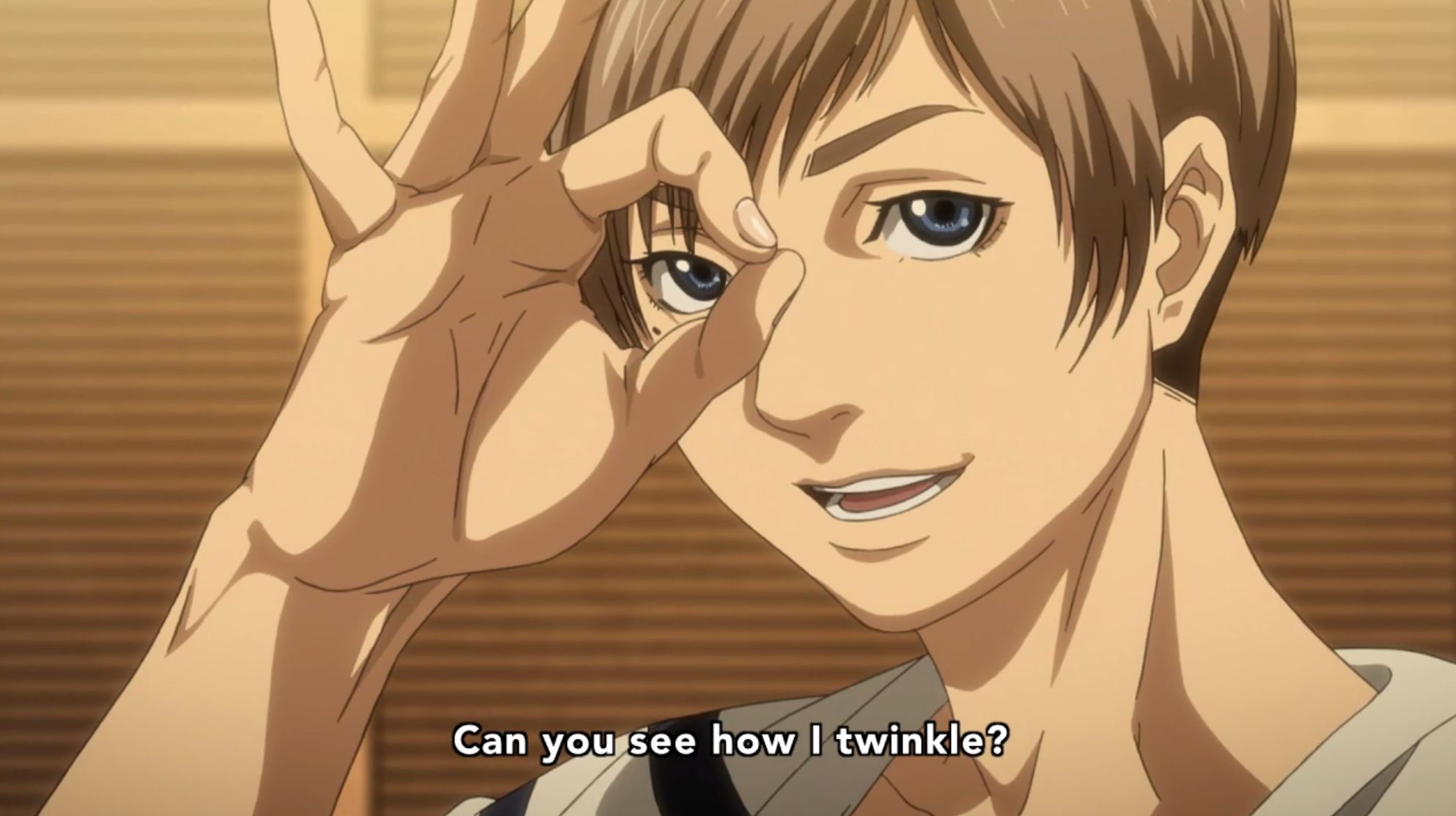
There is nothing I love more than idol shows. All the moe girls make my kokoro go doki doki. And only one thing makes my kokoro go doki doki more than moe idol girls, and that’s shounen idol boys. Uta no Prince-sama was a very pretty anime, and I enjoyed it very much as the fangirl I am. I am happy and pleased to see Zexcs jump on the boy idol bandwagon with Shounen Hollywood.
Shounen Hollywood is a good show, the best of the season, no doubt here! The episode opens with beautiful establishing shots with no animation (but who cares), with a young man telling us about his life. Most other idol shows wouldn’t do this as it is a cliche of various anime genres…but Shounen Hollywood does it. Our narrator is the smoking hot bishounen Kakeru Kazami, and he is recruited into the idol band, ‘Shounen Hollywood’, at age sixteen. Unlike other idol shows, it doesn’t show us the life of his manager, a lovely man who wants the best for his band. This show isn’t about him, I cry as I sob myself to sleep over and over again. It’s about Kakeru and his whimsical adventures as an idol.
It gets more glamorous from there on, I assure you. Shounen boys are rife! Brilliant animation! The characters are so not 2D-cut outs with no personality, and they are not defined by their hairstyles. This is realistic! They are normal people with dreams! This is like Wake Up, Girls!, that show is so realistic, and Shounen Hollywood is too. It’s brimming with all the things you expect from an idol show. These boys may never make the big time, but they made the big time in my heart. It all matters about the journey with barely-developed characters in the end. 5/5.
Now that I think about it, it would surprise me if the director wouldn’t remember their names. They have very memorable names. Like Kakeru and someone else.
Real talk, this show wasn’t half bad. I didn’t feel like time dragged on watching it, but it wasn’t interesting either. Characters are typical, but it’s only one episode, but with an idol show, I doubt anything will change. The character designs seem like they were ripped from Kuroko’s Basketball. It’s a typical idol show, overall. Music was nice from what I heard, and the animation was decent, especially from Zexcs. I also loved how the men didn’t have nipples. Free! inspires everything nowadays. What a big ball of nothing, and the title is too good for this show. — Mahou
Silver Will Argevollen

Oh look honey, the bad mecha show's trying to be self aware!
In yet another vaguely European fantasy mecha show continent, the mighty United Kingdom of Arandas has been shielded from invasion by a giant wall and an army of clunky, lumbering battlemechs known as Trail Kriegers for many years. That comes to an abrupt end when the National Federation of Ingelmia manages to blow a huge hole in said wall with an army of slightly less clunky mechs. Elsewhere, rookie pilot Tokimune is deployed into battle with veteran Silfy. After a civilian convoy gets attacked by Ingelmian forces, Tokimune breaks rank to try to save them only to get his Krieger trashed in the process. But all is not lost! You see that convoy was actually carrying a new prototype mecha known as the Argevollen and its perky civilian contractor Jamie. Ordered to jump in and save the day, Tokimune discovers the Argevollen can smash kick his enemy’s robots right in the face….because Trail Kriegers are terrible.
Right off the bat, Argevollen is suffering from major problems. For one, it screams Code Geass-ripoff with its stodgy Germanic mise-en-scene and telepathically controlled robot. Secondly, none of the characters are given proper introductions other than being bland millitary types who are just doing their jobs. There’s not a single personality to this bunch whatsoever. Very disappointing. Third, the robots themselves look like crap and/or other robots from other mecha shows. The Argevollen itself looks like the bastard love child of Bayformers Megatron and an Evangelion. Its hideous.
If there’s anything I can applaud the show for, its that the animation is surprisingly very good. Xebec’s work tends to be more miss than hit so its kind of a shock when it turns out well. Otherwise… skip it. — Lord Dalek
Space Dandy 2nd Season
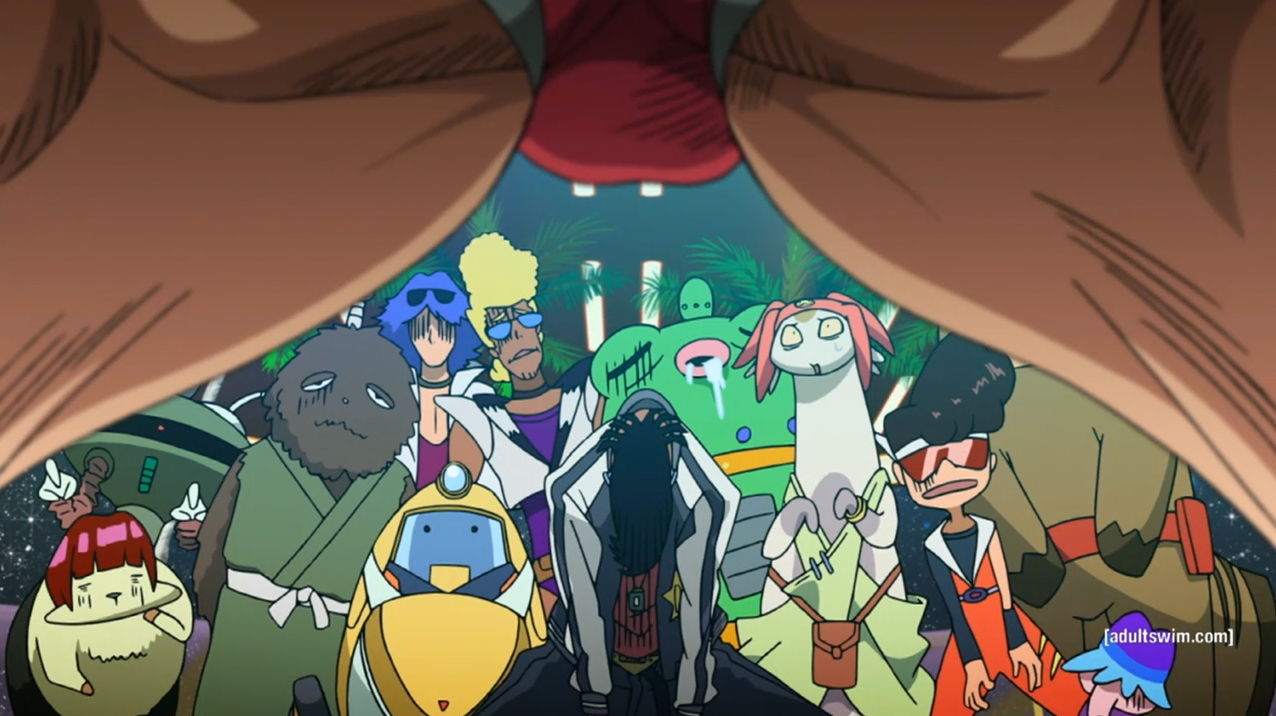
They wanna die.
I’m so glad this show is back. It’s only been a few months, but I missed Space Dandy immensely while it was gone. Over time, my opinion of it has only risen, so I’m elated that we somehow managed to get another season. This is one of those rare series that gets progressively better with each passing episode (mostly, anyway), and the season 2 premiere is no exception to this rule. The multiple dimensions theory I (and many others) prophesied finally comes into play in the latest installment, and while it doesn’t bring the show any closer to having a meaningful plot or any sort of continuity, it makes for a lot of excellent laughs that never fail to hit the mark.
As with many of Space Dandy‘s best episodes, this one is penned by the fantastic Kimiko Ueno, a scriptwriter I had never heard of before watching this anime. Much like her previous contributions to the series, the premiere features impeccable comedic timing and a lot of memorable visual gags. It’s an episode that’s simply overflowing with creativity and a joyous love for animation. The sheer amount of references to anime both new and old is staggering, and every moment manages to coalesce into something truly funny instead of coming across like vapid masturbatory dreck such as the ____ Movie films. The more you love anime – especially classic anime – the more you’ll love this episode, but the energy and effort are there to make things hilarious even for a newcomer to the medium. The eye-popping colors, occasionally glorious animation, and addictive music are still there in spades, and the ever-shifting art styles between dimensions display more than ever that Space Dandy is a true labor of love for the production staff at Bones.
Better still are the vocal performances. Ian Sinclair (yes, I watch the dub) does an amazing job playing all the various incarnations of Dandy from different dimensions. He even manages to sound enough like Patrick Warburton at one point that I could have sworn it was actually him. While some of the alternate versions of Meow are absolutely priceless in terms of both design and voice acting, Dandy’s VA ends up completely stealing the show in the end with his perfect line delivery as Emo Dandy. Revealing any more would spoil things, but I can say that it’s some of the funniest deadpan acting I’ve heard in a long time.
Overall, Space Dandy‘s 2nd season is shaping up to be every bit as good as the best episodes from the first one. People who hated the previous series should probably stay away, especially those who dislike the lack of storyline, since the premiere seems to promise that the show will never attempt to feature one. Lovers of great art/animation, groovy music, and silly/surreal comedy will continue to appreciate what this anime has to offer, and as one of those people, I can confidently say that this is my favorite series of the year so far. — Foggle
Survival Game Club!

Oh, you cheeky lil show you!
So, Survival Game Club or Sabagebu, as some of my colleagues would call it, C3-bu of 2014. Of course, this is the director and main writer of Love Lab teaming up again….and we know how good that show was (Heh I have yet to see, but been meaning to). Of course the animation is done by a Pierrot branch-off but then again main Pierrot surprised me with Still World is Beautiful last season.
The New Girl at all girls school, a pink-haired girl named Momoka (whose hair resembles a peach xD). Momoka has to look for a club as you know, most of these SoL shows tend to go. She met another student on the train who carries around a weapon openly in Japan I might add and it turns out she is part of a Survival Game Club with a cute (?) duck mascot. It is pretty much comprised of crazy gun nuts/possible terrorists. Momoka learns through their leader Miou to see the fun and excitement of gunplay and survival game. Also, it turns out that Miou-sama is quite the ladies’ lady, a hint of the possible yuri to come in this show. The premise seems to be a combo of Yuyushiki and C3-bu. Now, while some might find that tiring, I don’t mind it as much. If one doesn’t have new ideas and only old established ideas to work with, then you got to bring something else and I believe that Sabagebu does bring that to a point. Hoping it doesn’t derp like C3-bu as a fellow blogger pointed out to me.
Of course, the episode is split into three separate stories. The other members of the Survival Game Club: Maya (model), Urara (cute one who may or may not be Miou’s lesbian gf), Kayo (the quiet emotionless one). What I like, apart from the yuri subtext, is the nice quick rapid fire humor and comedy. Its the same thing that drew me to D-Frags as well from earlier in the year. In fact the animation, despite looking on the cheap side, is quite pastelly-colorful, lively and energetic, fitting for a comedy. There’s a nice game battle sequence in the last third of the episode.
All in all, a good first outing for a profoundly silly show. Of course, if you’re cynical about yet another girls club anime, then well I don’t know what to say. Different strokes for different folks, I suppose. — The Eclectic Dude
Second Opinion!
Sonokawa Momoka is a girl kinda fed up with her life and is trying to deal with shit in the most non-confrontational way possible. However a chance encounter with one Mio Ootori, a bullet-slinging buxom bombshell of a babe, leads her down a dark path into the Survival Games Club. From there, she becomes part of an eccentric group of girls both praised and feared throughout school and city, all the while having fun with guns.
I’m getting a big Azumanga Daioh/Galaxy Angel vibe with this anime, which is great because I love both those things. Characters are wonderfully quirky enough, letting their vices and virtues go hog-wild over good taste and sanity, and serve as great foils to one another. Add in a narrator who may outshine Daimidaler’s narrator in acerbic exposition and brusque frankness, and you have got the kind of anime that may not be laugh out loud hilariousness, but just smile inducing.
That’s always something worth having, and as long as Sabagebu has that, I won’t be complaining. I like these girls, they (in the words used to describe the Galaxy Angel cast by Mike Toole so long ago) are “feisty. They’ve got gumption.” — The Juude
Sword Art Online II

They're back, and it's about time....I consider killing myself.
Ah, Sword Art… the name just fills me with a nostalgic tingling. Remembering back to the time I became first aware of SAO, I was in the winter of my 27th year. In those days I was just getting back into anime, devoting time to it that I could have spent with other girls. But then two men of somewhat ill-repute sat me down in front of it and we watched for days on end, latter dragging on into weeks as we huddled around our computers while the latest adventures of Kirgaya Kazuto-kun became available over miles and miles of fiber optic wiring plugged into a massive electronic hub mind. In the two years of anime that followed with a glopping sound, I was challenged with other shows that dared to be like the revolutionary marvel that was SAO however none compared. And now… the time has come to return to that nostalgic world and the soothing warmth it brings to our souls…
So let me begin this tale by informing you where we are in the ongoing saga of Kirito-shi and Asuna-san. This is the third arc, collectively known as Phantom Bullet, a name that is meant to strike ominously within the body of your soul. It is also known as “The Death Gun” and GunGale Online, which is the title of the MMO (Massively Multiplayer Online) FPS (First Person Shooter) that Kirito-shi finds himself playing while in the safe confines of his 10 tatatami room. In this story, Kirito-shi is hired by Kikuoka-shi (last seen in the SAO Special) to investigate a set of mysterious murders in connection with GGO. There is also a girl with blue-hair named Sinon who graces our screens for all of two minutes leaving behind a gaping void in my worldview.
SAO II is reunion of the staff that brought us the original from their large offices in Suginami-ku. Thousands of solid state chipboards were used to create its vast panorama of fine dining establishments and parks. Matsuoka returns as Kirito and is vastly superior to that faker who didn’t know what true love was last season. Asuna is here as well and it is so lovely to see her chestnut colored hair and perfect egg-shaped head. Klein was not in this episode but who cares about him or Eagle, not I he said. Hopefully we will get an adaptation of 008.2 Calibur this season, that is CLEARLY my favorite SAO story starring Sinon
All in all a ravishing success! — Loreki Dalekawahara
…in other words it’s boring as sin. You’d get the same experience by watching a tutorial video in how to reassemble a vacuum cleaner.
Second Opinion!
Japan’s #1 Choice for Effective Birth Control is back!
FUCK! And I was KINDA getting into it before I found out some bad guy’s name is Death Gun and the logo reminded me I’m STILL watching SAO.
Anyway, it’s been about a year’s worth of semen making a glopping noise since Kirito saved Asuna from being raped by creepy Koyasu, and the MMO du jour is Gun Gale Online. Unfortunately like Aincrad and Fairy Dance, there is trouble afoot as Mr. Death Gun (DESU GAN!) is somehow murdering high-level players with impunity. Now Kirito, still in a relationship with Asuna, is asked (remember that) by some government official we met in the previous OVA, to stop him.
That’s pretty much it for this so-called ‘premiere’, which is handled EXACTLY the same as the OVA. There is very little online play, Kirito spends a bit of time with his #1 fuckpuppet, has a long winding exposition with government guy, and then nothing gets done. All of this is done without much motivating Kirito as I said before, he was ASKED to do this. He isn’t trapped in the game like Aincrad or has to save Asuna, oh he’s just asked to go online and stop them. Yeah he establishes sympathy for all those lost on Aincrad for apparently there’re more murders online now than then, but without anything REALLY driving him it falls flatter than usual. Then it gets insulting when he pleads modesty on not being good enough to go onto GGO. After two series of godhood and then an opening theme that has him slaughtering players (with a SWORD of course), that humility comes off as absolutely superficial.
I expect nothing less from this anime. Looking forward to what cheap tricks Kirito will pull out his ass to win, how the new female lead’s squishbox will eventually enervate her independent spirit after she meets Kirito, and how Asuna and Yui perpetuate negative female stereotypes by being barefoot, possibly pregnant, and being forced into religion instead of joining Kirito in the fight against DESU GAN.
I’d say avoid, but if you’ve already invested in this incredible trainwreck, you better keep going. No time for desertion, soldier! Finish this tour of duty into the maw of Hell! — The Juude
Tokyo Ghoul

Smoosh, smoosh.
The streets of Tokyo are under attack yet again. This time its from Ghouls, monsters with black eyes who eat human flesh when all other food stuffs cause them to vomit profusely. That being said, life still goes on for hard luck college student Kaneki whose finally scored a date with bland Senjyogahara-clone Rize…but then she tries to eat him…whoops. It all ends rather badly. Kaneki survives but with Rize’s ghoul organs stuck in him after the worst doctor in the world says “you know what? Fuck the Hippocratic Oath”. Now he’s stuck with the munchies but teetering between sanity and madness since he’s only half a ghoul. To make matters worse, he’s caught in a turf war between Ghouls over feeding grounds and the police who are naturally trying to wipe em out. Poor guy.
Tokyo Ghoul is obviously a horror anime, albeit one with a sick sense of humor about itself. Within the first five minutes, a guy in a Jason Vorhees goalie mask is fighting a crazy bitch who constantly smooshes her face against aquariums. Clearly this is going to be something of a show, and a good one at that. No really, this one’s surprisingly a lot of fun for a show drenched in blacks and dark blues. The main guy’s such a poor schlub that you can’t help but pity him and that’s what makes Kaneki so relatable. He didn’t ask for this bs to happen to him, and now that it has, he has to embrace to survive. Its a nifty concept.
Animation is by Pierrot and is pretty good. Clearly the company cares when they don’t have to endlessly churn out Shippuden to satisfy the hungry masses of…actually I’m not sure anymore. Special props to the soundtrack here as well, its heavy on nervous strings and adds the growing horror/disorientation of Kaneki as he gradually learns of the horror that he has become. Surprisingly well done effort all around. — Lord Dalek
Second Opinion!
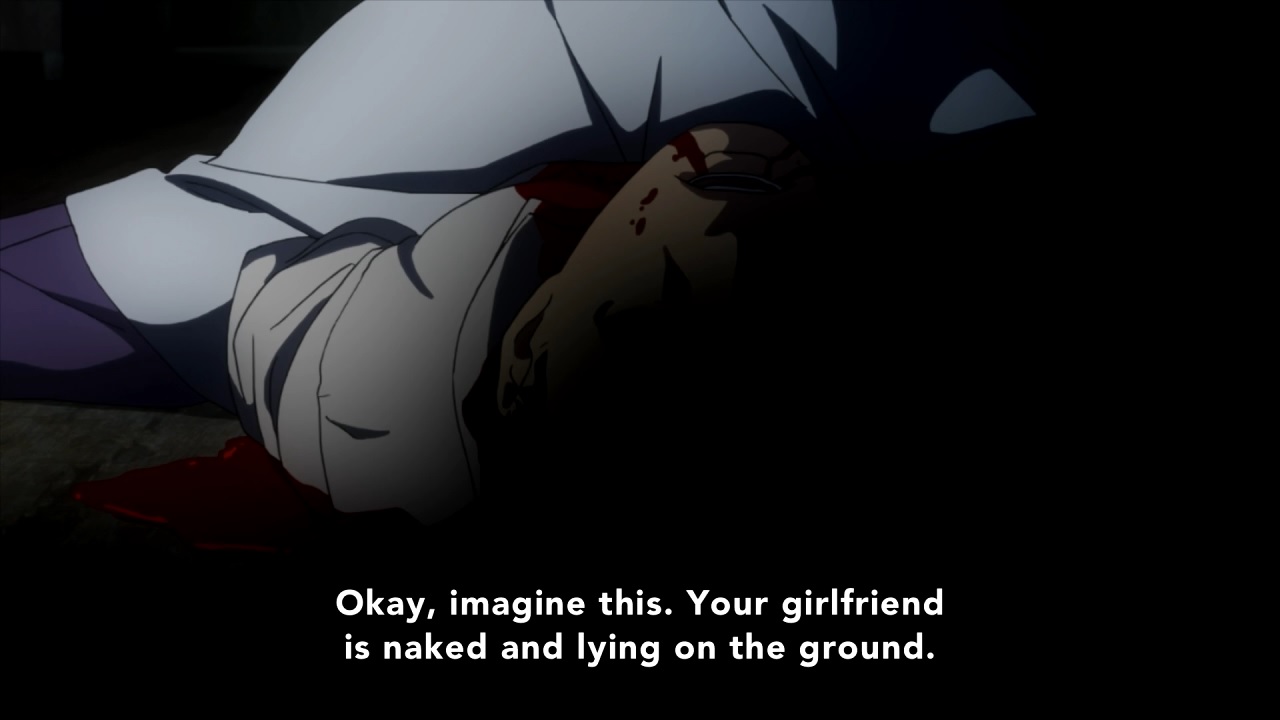
This first episode struck me as a reaction against Bakemonogatari, with how Ken’s demonization is brought on by a girl with Senjougahara’s hair, Hanekawa’s glasses, Shinobu’s role, and Sengoku’s voice. It provides a similar execution, but offers a twist to the method. Instead of being overly contemplative of what’s going on, it lets the actions speak for themselves as Ken goes through the mutative motions. Unlike Monogatari, you thrust into the moment rather than watching characters talk to each other as if you’re a voyeur. It’s a show that values directing much more than dialogue, which could present a challenge as much as a possible breakthrough if not utilized properly in future episodes. I particularly enjoyed that scene where he struggles to eat the burger, with the knowledge that his favorite food has become pure swill to his new incarnation. The way he immediately rejects the food seems like something above the usual roster that horror anime often gives. It certainly has the potential to abuse the shock value though, so there’s always that to be wary about.
Sure, it’s a bit predictable for the more seasoned viewers, but it makes the scenes no less interesting to watch. I’m a bit surprised that this is coming from Pierrot too. After all, this comes from the guys who phone in an episode of Naruto week by week for the past decade. Who the hell expects them to make something watchable nowadays? If anything, coming from a shoddy anime studio makes the show feel a bit more down-to-earth. It doesn’t offer the familiarity you would get from Madhouse or A-1 Pictures animation, putting any sense of off-animation in its favor in order to create a world that doesn’t feel right, one that could generate such beasts like the ghouls in the show.
But even with the twists, this premiere doesn’t pull out much volatility. Many events in this episode feel like echoes from prior shows, where Durarara and Mirai Nikki seem not too far away. This show does not have an original premise, since any shonen manga can boast a main character who is half-something. The real work goes into using those elements to make a unique combination though, which I really do hope to be the case for this show. But if this turns out to become stupid in later episodes, at least the Pierrot guys have a night job when Naruto eventually dies. — Bloody Marquis


